Abocom Systems WB1K5 WLAN PCMCIA Card User Manual manual EMC
Abocom Systems Inc WLAN PCMCIA Card manual EMC
Users Manual Revised
M73-APO01-xxx
802.11b Wireless 16bit
PC Card
User Manual
REGULATORY STATEMENTS
FCC Certification
This model 802.11b Wireless PC Card (WB1500)
must be installed and used in strict accordance with
the manufacturer’s instructions as described in the
user documentation that comes with the product.
The United States Federal Communication Commission
(FCC) and the Canadian Department of Communications
have established certain rules governing the use of
electronic equipment.
Part15, Class B
This device complies with Part 15 of FCC rules.
Operation is subject to the following two conditions:
1) This device may not cause harmful interface, and
2) This device must accept any interface received,
including interface that may cause undesired
operation. This equipment has been tested and found
to comply with the limits for a Class B digital device,
pursuant to Part 15 of the FCC Rules. These limits are
designed to provide reasonable protection against
harmful interference in a residential installation. This
equipment generates, uses and can radiate radio
frequency energy, and if not installed and used in
accordance with the instructions, may cause harmful
interference to radio communications. However, there
is no guarantee that interference will not occur in a
particular installation. If this equipment does cause
harmful interference to radio or television reception,
which can be determined by turning off and on, the
user is encouraged to try to correct the interference by
one or more of the following measures:
◗ Reorient or relocate the receiving antenna.

◗ Increase the distance between the equipment and
receiver.
◗ Connect the equipment into an outlet on a circuit
different from that to which the receiver is connected.
Warring: Changes or modifications not expressly approved by party
responsible for compliance could void the user the user authority to
operate the equipment.
CAUTION:
This transmitter must not be co-located or operating in conjunction with
any other antenna or transmitter.
U.S Service Center:
D-LINK CORPORATION
53 DISCOVERY DRIVE, IRVINE CA 92618, USA
TEL: 714-788-0805
Table of Contents
INTRODUCTION ...........................................1
WIRELESS BASICS ............................................1
802.11B WIRELESS 16BIT PC CARD .................1
FEATURES.........................................................2
WIRELESS NETWORK OPTIONS.........................3
The Peer-to-Peer Network ...................3
The Access Point Network...................4
LED INDICATORS .............................................5
Link: Orange (On/Blink) .....................5
Act: Green (ON/OFF)..........................5
HARDWARE INSTALLATION ....................6
SOFTWARE INSTALLATION .....................7
INSTALLATION FOR WINDOWS 95 (OSR2) .......7
INSTALLATION FOR WINDOWS 98...................11
INSTALLATION FOR WINDOWS ME.................15
INSTALLATION FOR WINDOWS 2000...............18
INSTALLATION FOR WINDOWS XP..................22
NETWORK CONNECTION ........................26
CONFIGURING THE NETWORK PROTOCOLS FOR
WINDOWS 95 (OSR2)/98/ME/2000 ...............26
CONFIGURING THE NETWORK PROTOCOLS FOR
WINDOWS XP.................................................29
CONFIGURATION UTILITY .....................32
NETWORK STATUS ICON & ICON MENU.........32
The Status Icon ..................................32
Icon Menu..........................................33
STATUS...........................................................34
CONFIGURATION ............................................35
ENCRYPTION ..................................................38
SITE SURVEY ..................................................40
ABOUT............................................................41
CONFIGURATION FOR WINDOWS XP ..............42
SPECIFICATIONS .........................................48

- 1 -
Introduction
Wireless Basics
Compliant with IEEE 802.11b, the 802.11b
Wireless 16bit PC Card provides an ideal
solution for users to enjoy the instant
connectivity via a wireless local area network
(LAN). A wireless LAN is like a regular LAN,
except that you can share information anywhere
without looking for a place to plug in, and
augment networks without installing or moving
wires. Based on radio frequency (RF)
technology, a wireless LAN transmits and
receives data over the air, along with the
guarantee to ensure privacy and noninterference
by the use of separate radio frequency.
802.11b Wireless 16bit PC Card
The 802.11b Wireless 16bit PC Card lets you
take full advantage of your PC’s mobility with
access to real-time information and online
services anytime and anywhere. Plus, with the
network installation’s simplicity and flexibility,

- 2 -
you can eliminate the needs to pull cable through
walls and ceilings and allow the network to go
where wires cannot go. Exploring WWW and
augmenting networks can never be done more
easily.
Features
Compliant with IEEE 802.11b standard for
2.4GHz Wireless LAN
Compliant with PCMCIA Type II
Supports PC Card hot swap and true Plug
& Play
Works with all existing network
infrastructure
Compatible with specific wireless products
and services
Capable of up to 128-Bit WEP Encryption
Protocol
Freedom to roam while staying connected
11 Mbps High-Speed Transfer Rate
Rich diagnostic LED indicators with
Integrated Antenna
Compatible with Window 95(OSR2)/98/
2000/ME/XP
Lower power consumption
Easy to install and configure
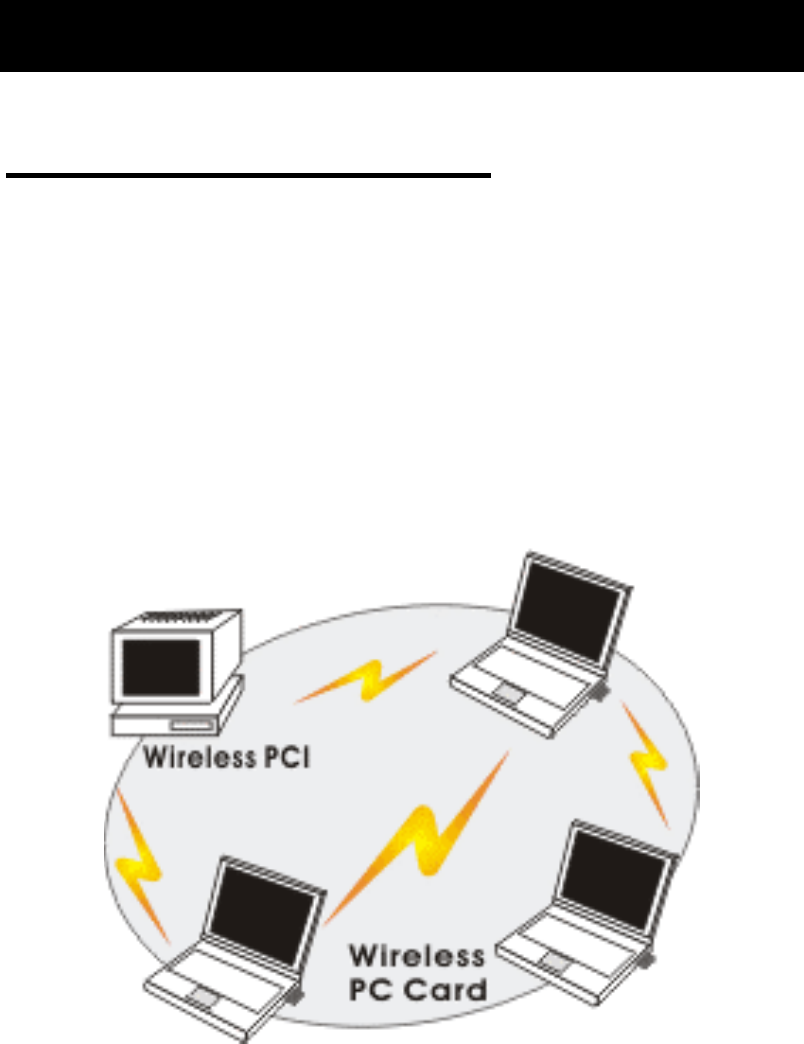
- 3 -
Wireless Network Options
The Peer-to-Peer Network
This network installation lets you set a small
wireless workgroup easily and quickly.
Equipped with wireless PC Cards or wireless PCI,
you can share files and printers between each PC
and laptop.
Or you can use one computer as an Internet
Server to connect to a wired global network and
share files and information with other PCs via a
wireless LAN.
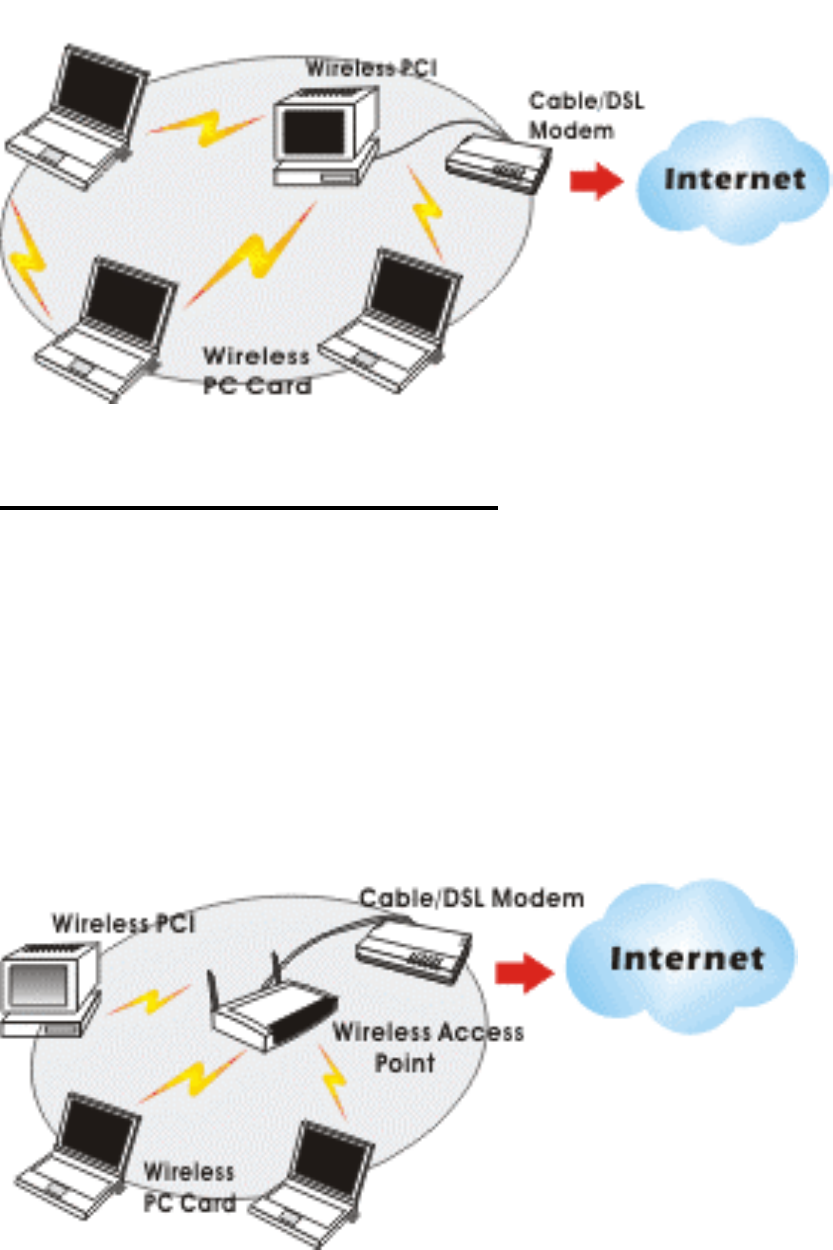
- 4 -
The Access Point Network
The network installation allows you to share files,
printers, and Internet access much more
conveniently. With wireless PC Cards, you can
connect wireless LAN to a wired global network
via an Access Point.

- 5 -
LED Indicators
Link: Orange (On/Blink)
Access Point Mode
Grow – linking to an Access Point.
Blink – searching for Access Points in the
networks.
Peer-to-Peer Mode
Grow – forming a Basic Service Set or joining
to a Basic Service Set.
Blink – searching for other wireless LAN
cards in the wireless network.
Act: Green (ON/OFF)
Transmitting/receiving wireless data

- 6 -
Hardware Installation
1. Locate the PCMCIA slot of your system.
2. Align the Wireless PC Card toward the
PCMCIA slot. Push evenly and steadily until
it is seated.
3. You are now ready to continue the software
installation.
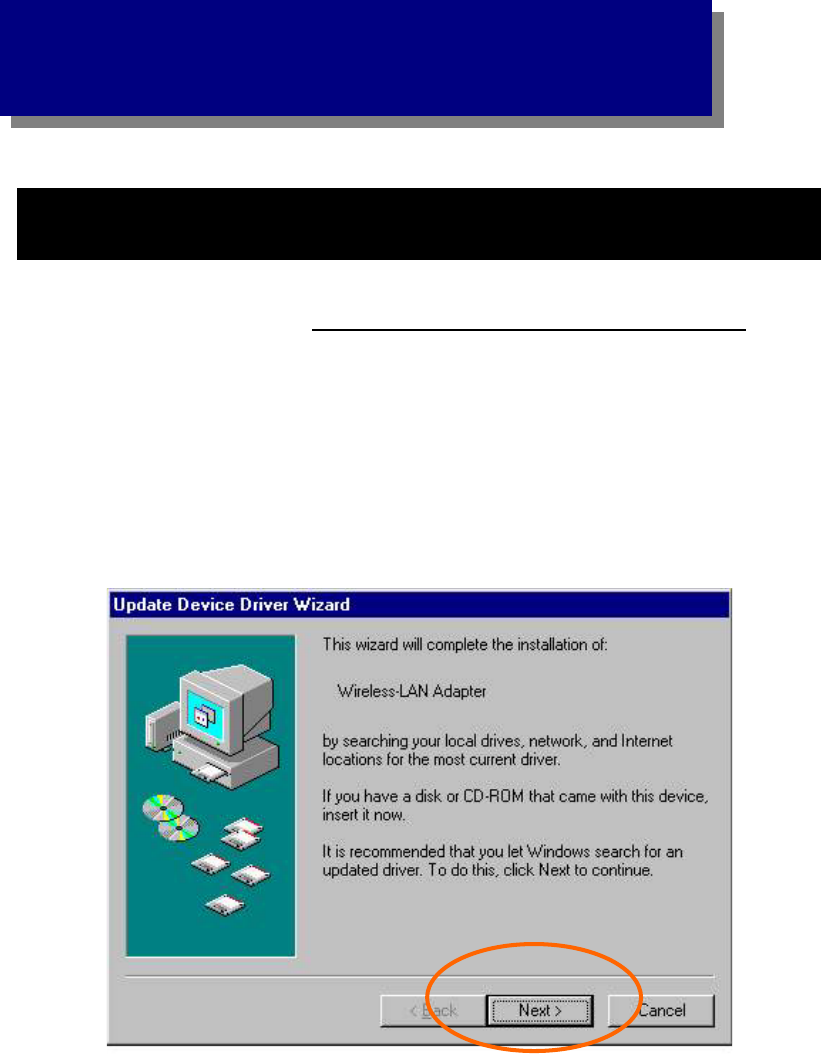
- 7 -
Software Installation
Installation for Windows 95 (OSR2)
1. Once the Wireless LAN Adapter is
connected to your computer, Windows 95
(applicable for Windows OSR2 only) will
automatically detect the new hardware
device as shown below. Click Next.
2. Insert the device driver diskette into your
floppy drive.
3. Windows will find the driver for this device
automatically. Click Finish.
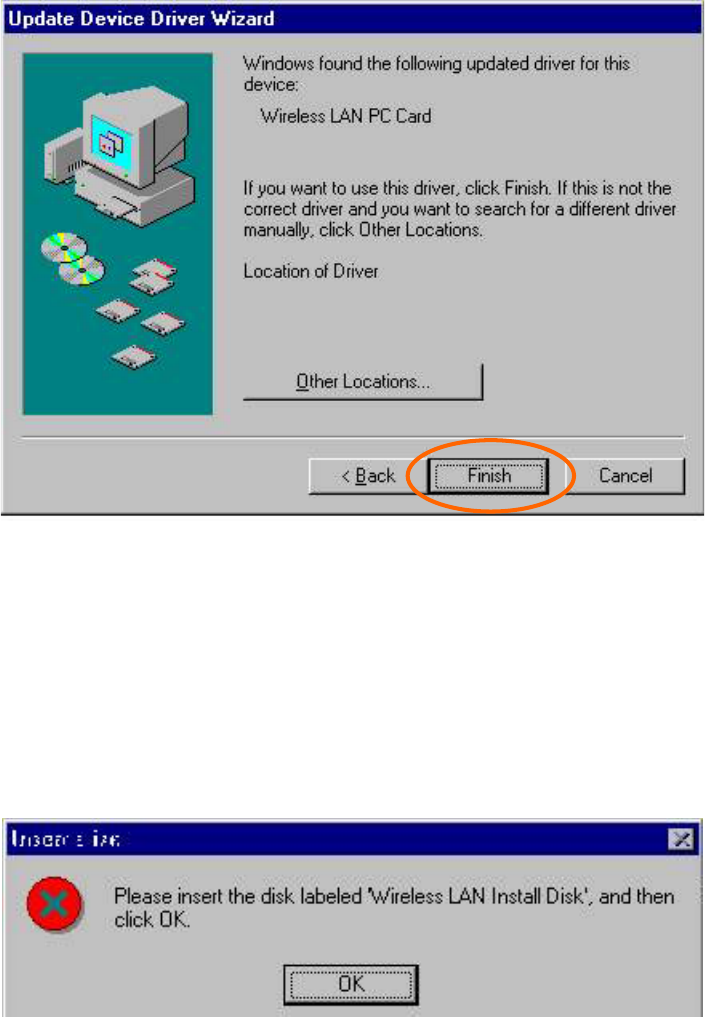
- 8 -
4. While copying the necessary files into your
system, Windows prompt a message asking
for the Wireless LAN Install Disk. Click
OK to proceed.
Note that you have to direct Windows to copy
the needed files from the root directory (A:).
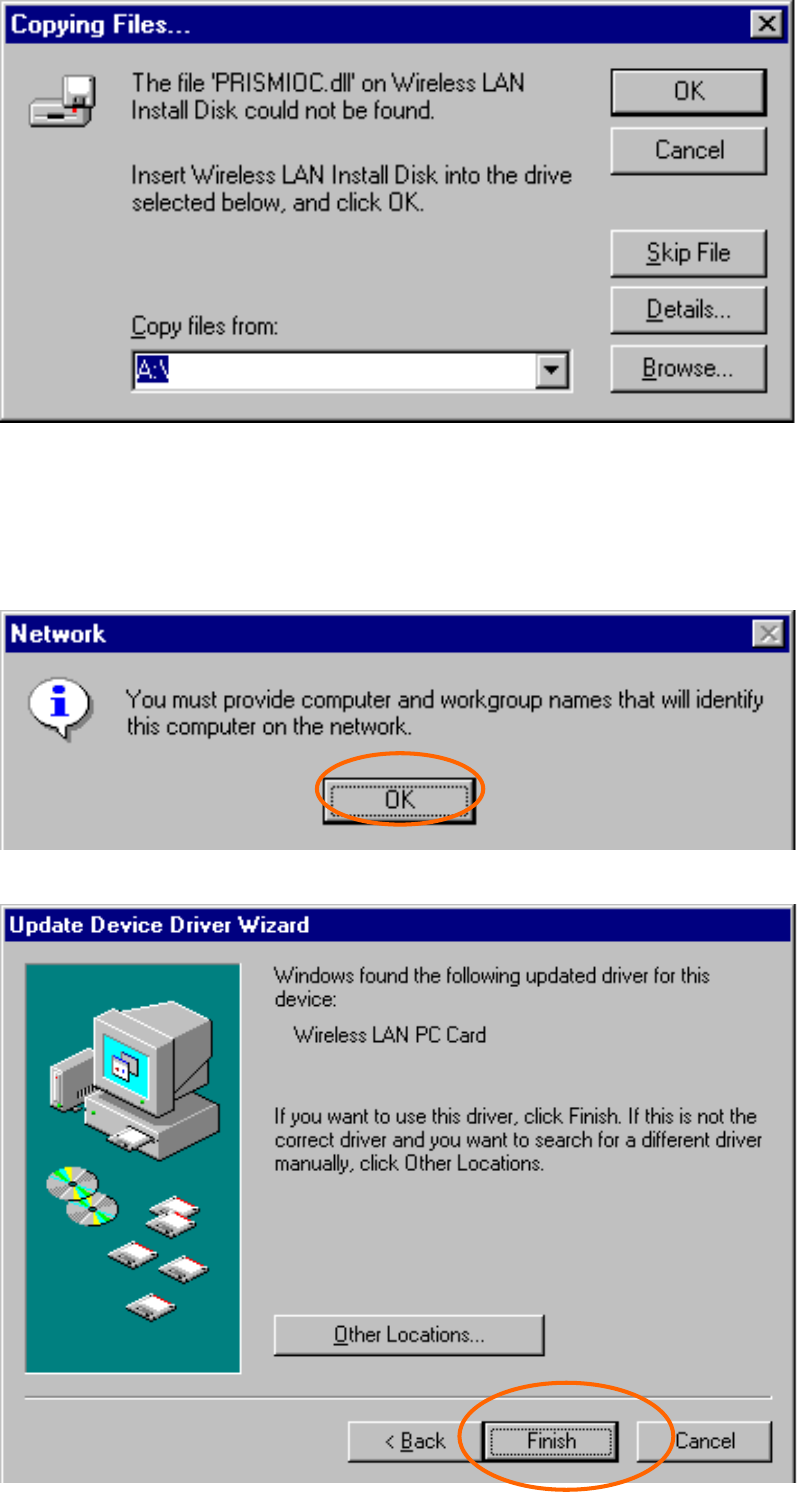
- 9 -
5. When copying files is done, click OK when
the following figure appears.
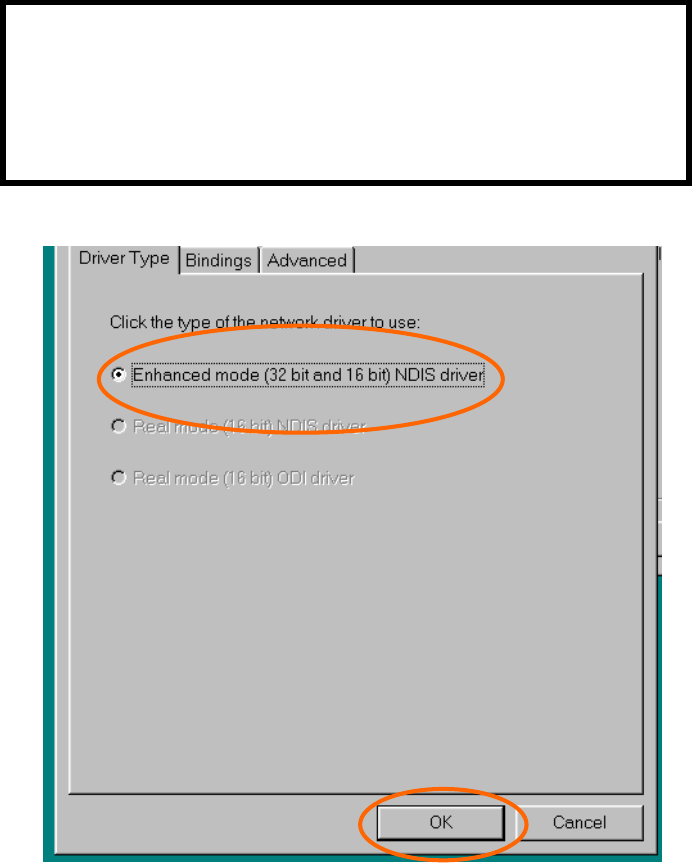
- 10 -
6. The Wireless LAN PC Card Properties
window will appear. The modification of
default settings may result in network errors.
It is recommended to remain the default
settings. Click OK.
Note: For the detailed ways to configure the
wireless PC Card, please refer to the
Configuration Utility section.
7. Windows may prompt you to insert
Windows 95 CD-ROM in the selective drive.
Please do so to have Windows copy all the
necessary files to your system.
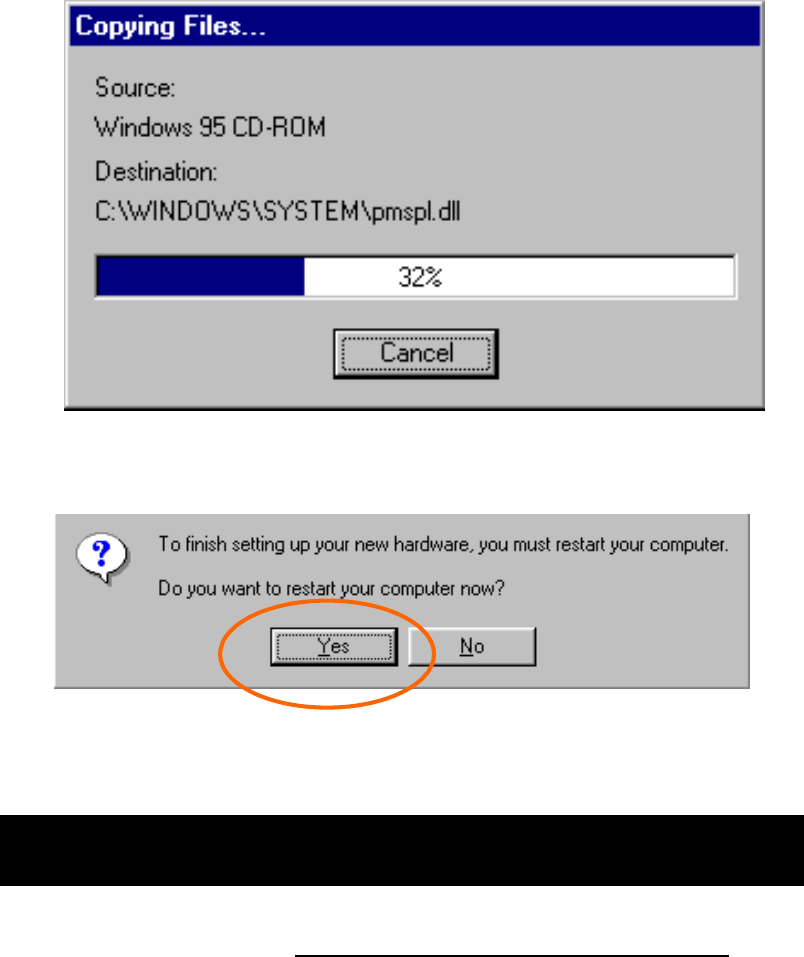
- 11 -
8. Click Yes to restart your computer.
Installation for Windows 98
1. Once the Wireless LAN Adapter is
connected to your computer, Windows 98
will automatically detect the new hardware
device as shown below. Click Next.
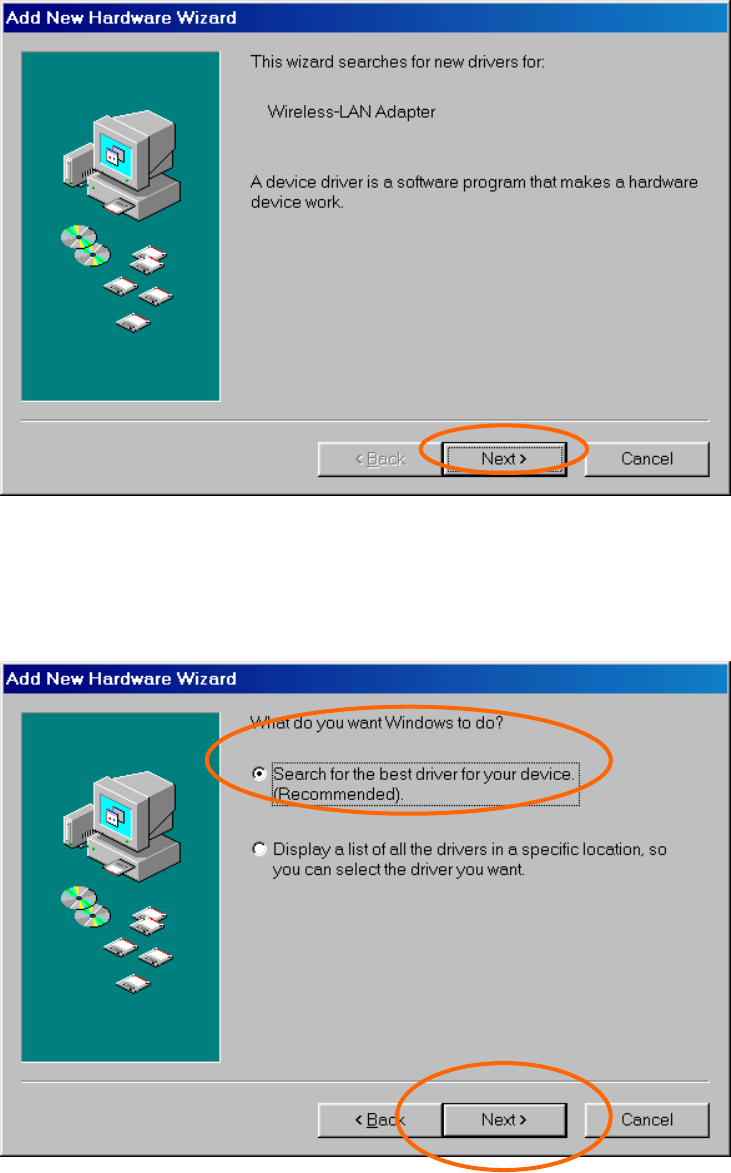
- 12 -
2. Insert the device driver diskette into your
floppy drive. Click Next.
3. Select Floppy disk drives and click Next.
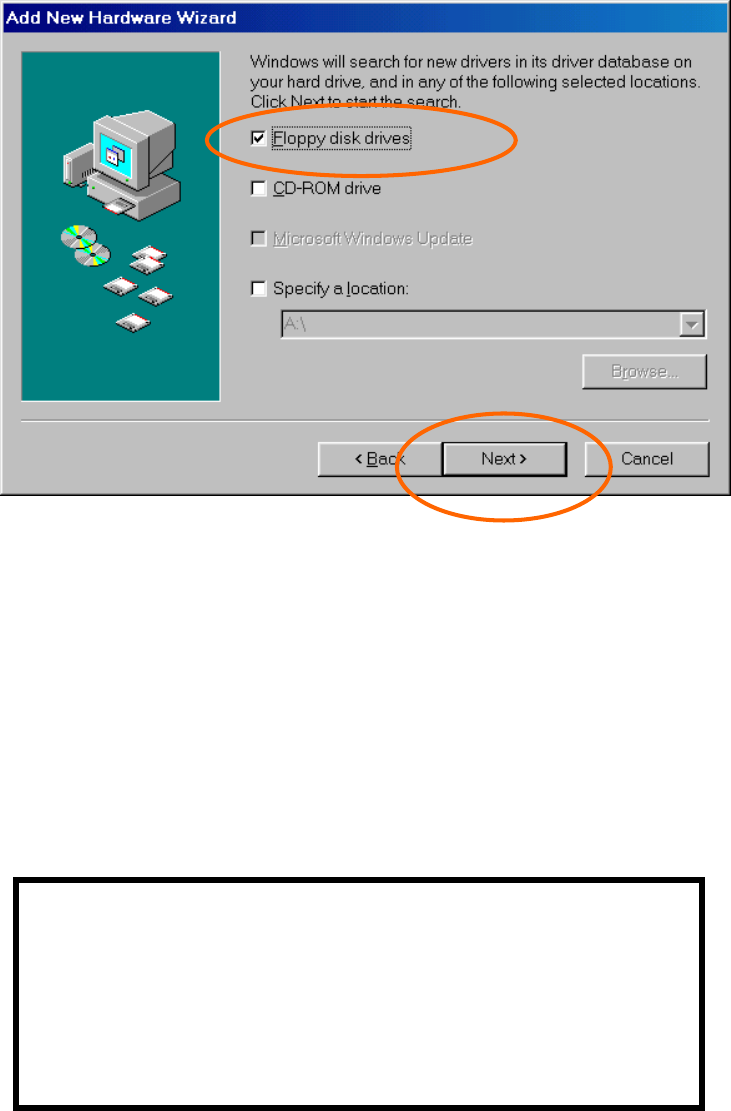
- 13 -
4. Click Next.
5. The Wireless LAN PC Card Properties
window will appear. The modification of
default settings may result in network errors.
It is recommended to remain the default
settings. Click OK.
Note: For the detailed ways to configure the
wireless PC Card, please refer to the
Configuration Utility section.
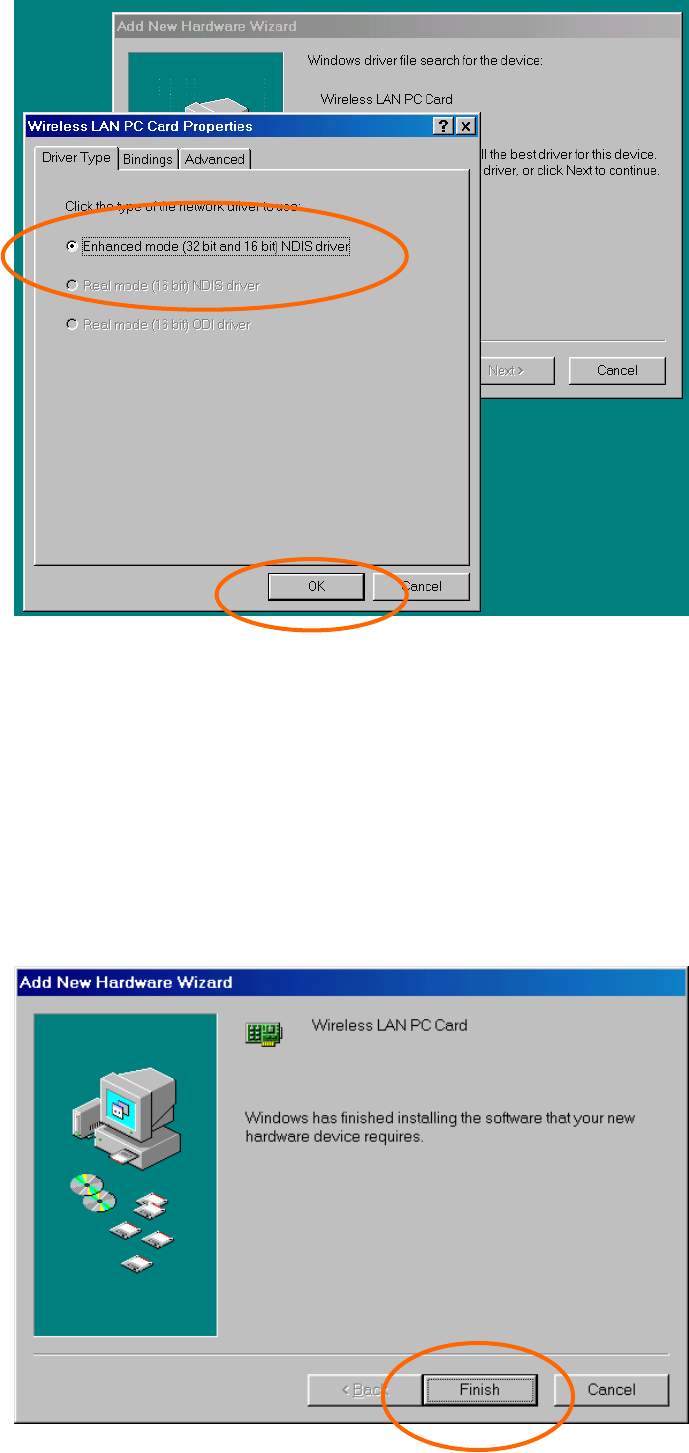
- 14 -
6. Windows may prompt you to insert
Windows 98 CD-ROM in the selective drive.
Please do so to have Windows copy all the
necessary files to your system. . When the
following window appears, click Finish.
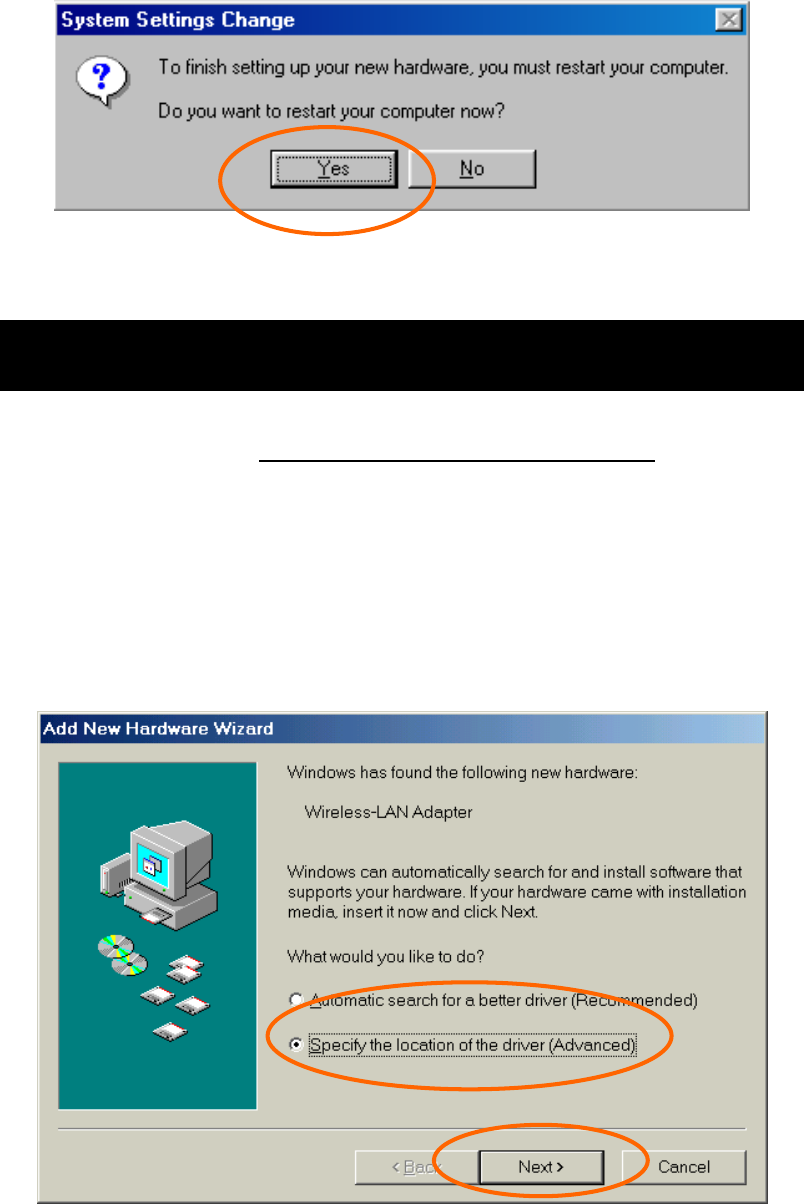
- 15 -
7. Click Yes to restart your computer.
Installation for Windows ME
1. Once the Wireless LAN Adapter is well
connected to your computer, Windows ME
will automatically detect the new device.
Select Specify the Location of the driver…
and click Next.
2. Insert the device driver disk into the floppy
disk drive on your system. Select
Removable Media (Floppy, CD-ROM…)
and click Next.
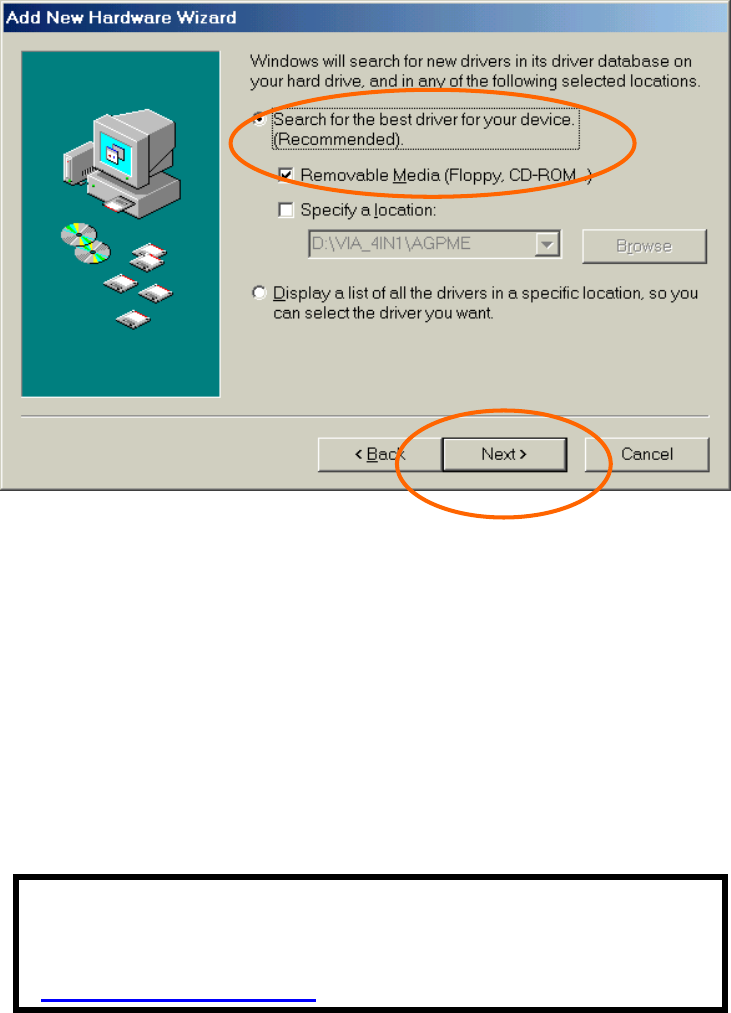
- 16 -
3. Click Next.
4. The Wireless LAN PC Card Properties
window will appear. The modification of
default settings may result in network errors.
It is recommended to remain the default
settings. Click OK.
Note: For the detailed ways to configure the
wireless PC Card, please refer to the
Configuration Utility section.
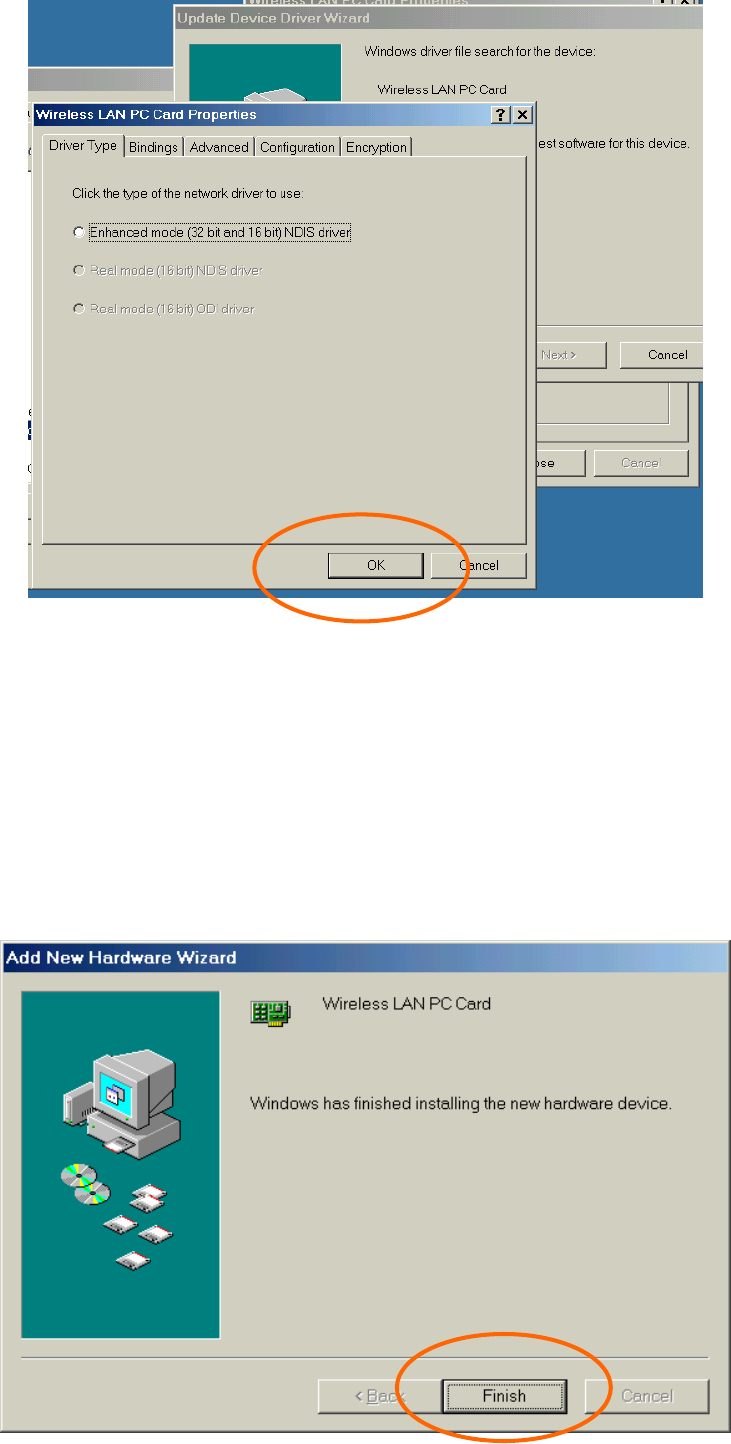
- 17 -
5. Windows may prompt you to insert
Windows ME CD-ROM in the selective
drive. Please do so to have Windows copy all
the necessary files to your system. . When
the following window appears, click Finish.
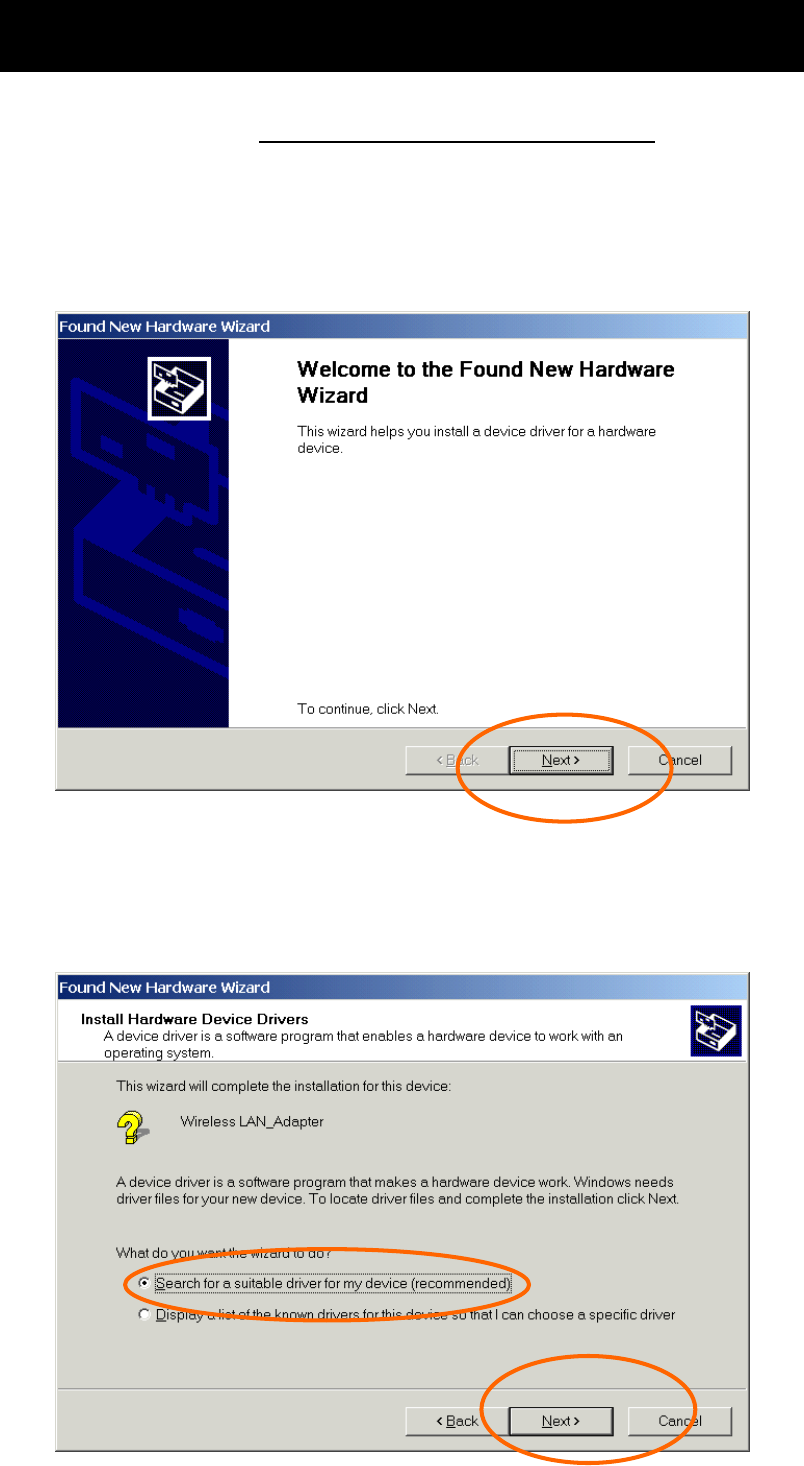
- 18 -
Installation for Windows 2000
1. Once the Wireless LAN Adapter is well
connected to your computer, Windows 2000
will automatically detect the new device.
Click Next.
2. Select Search for a suitable driver… and
press Next.
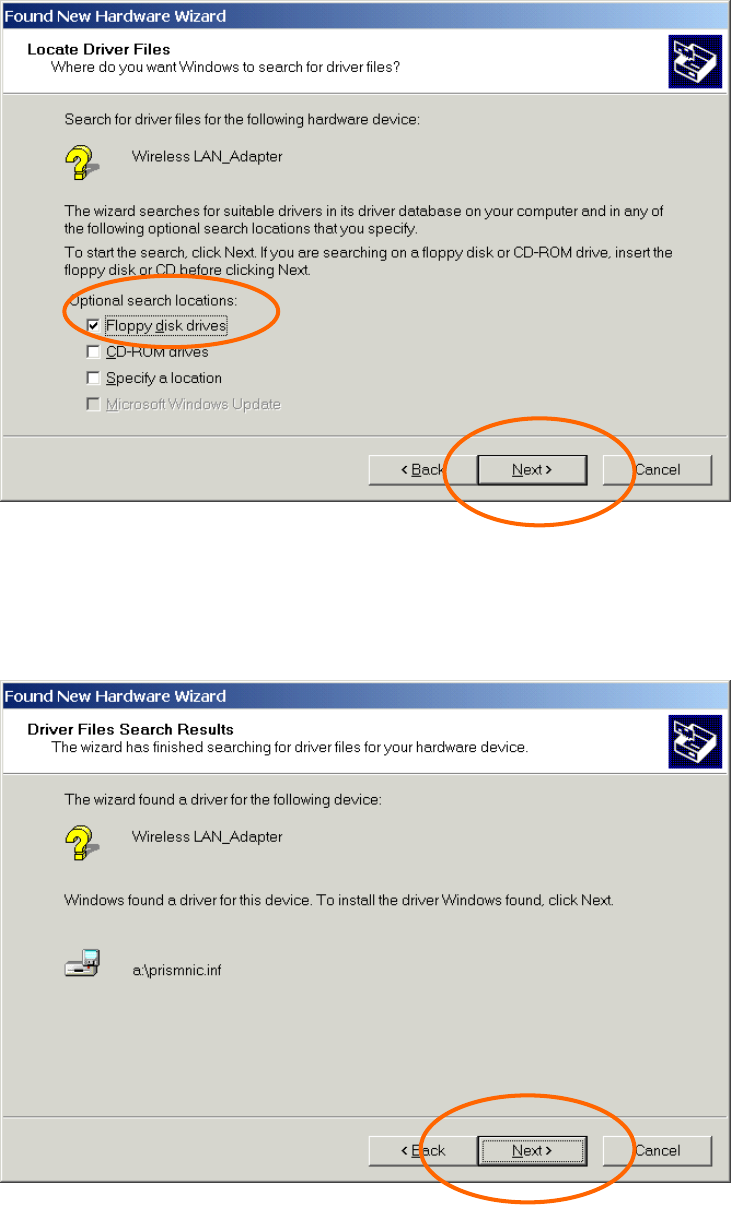
- 19 -
3. Insert the device driver diskette into your
floppy drive. Select Floppy disk drives
and click Next.
4. Click Next to continue.
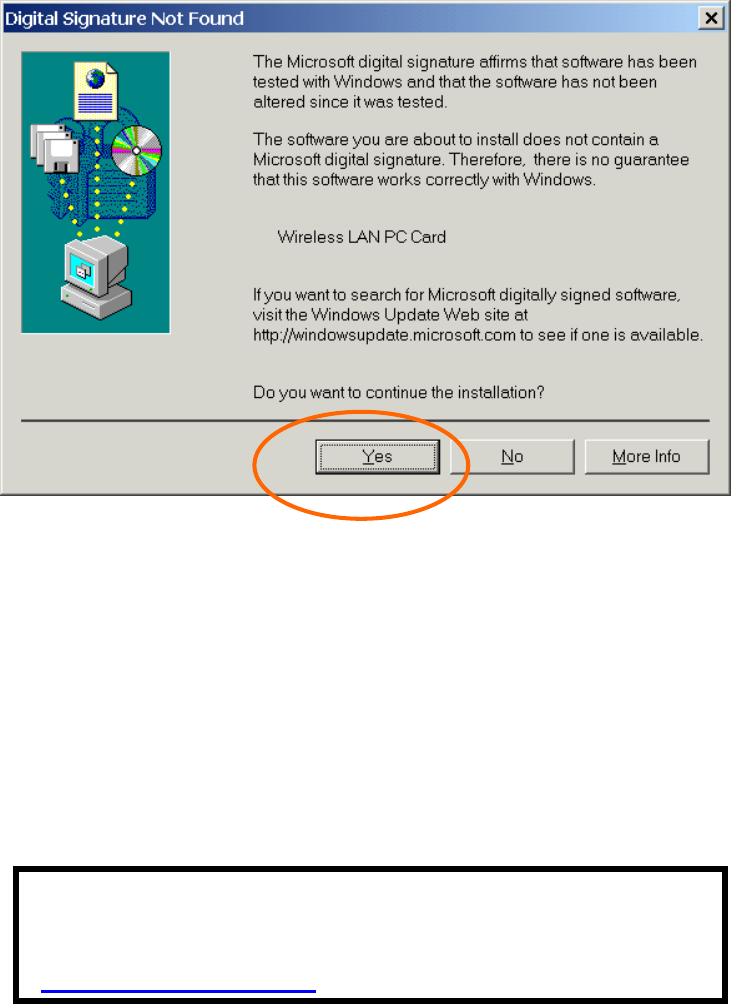
- 20 -
5. Click Yes to continue.
6. The Configuration window will appear and
prompt you to configure the Network PC
Card’s driver software, but the modification
of default settings may result in network
errors. It is recommended to remain the
default settings. Click Next to proceed.
Note: For the detailed ways to configure the
wireless PC Card, please refer to the
Configuration Utility section.
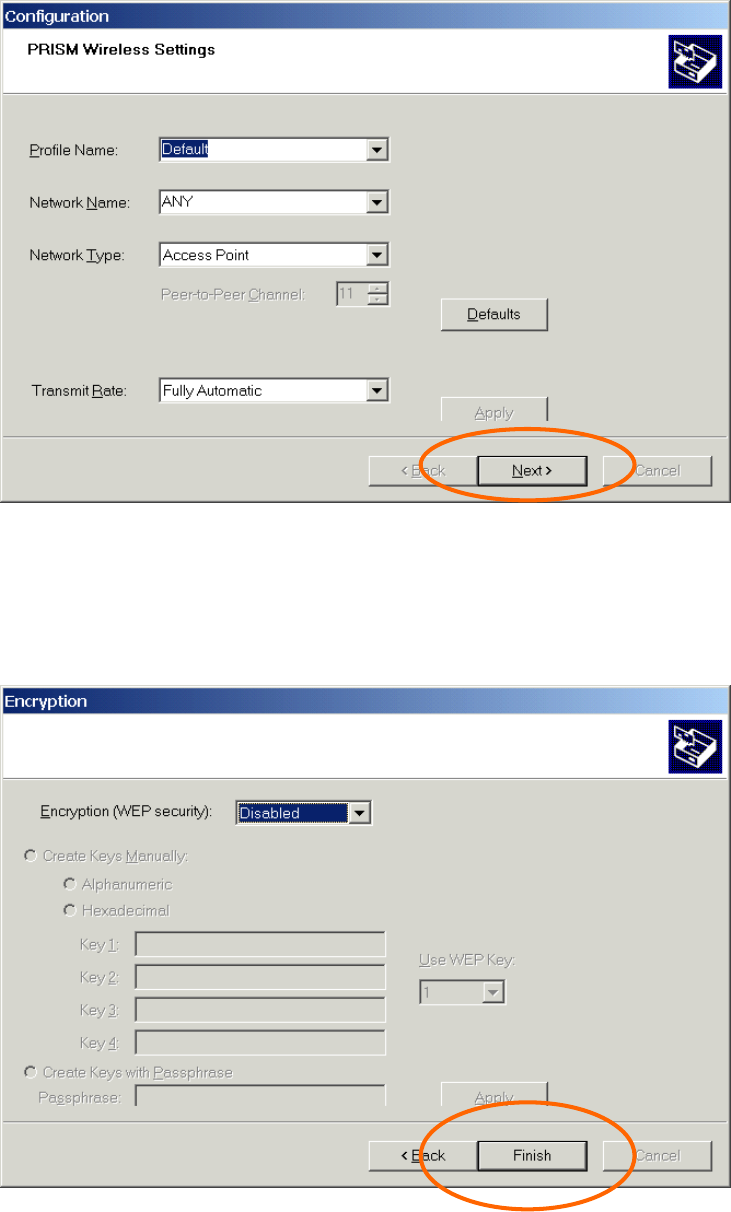
- 21 -
7. Click Finish. The PC Card driver
installation is successfully completed.
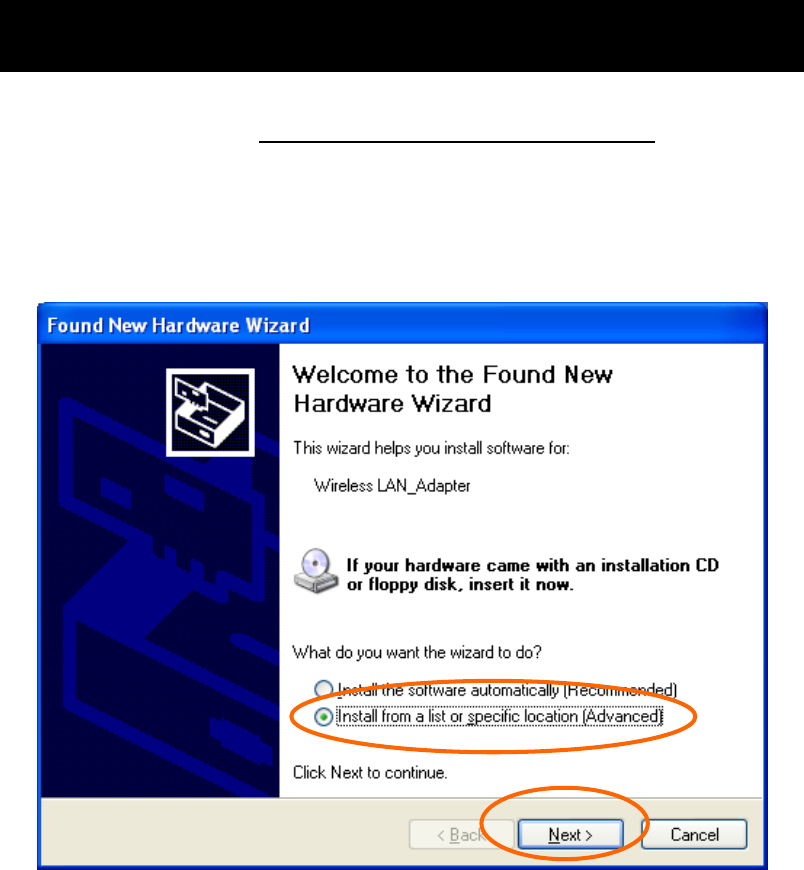
- 22 -
Installation for Windows XP
1. Once the Wireless LAN Adapter is well
connected to your computer, Windows XP
will automatically detect the new device.
Click Install from a list… and click Next.
2. Insert the device Driver Disk into the floppy
disk drive on your system. Select Search
removable media (floppy, CD-ROM…)
and click Next.
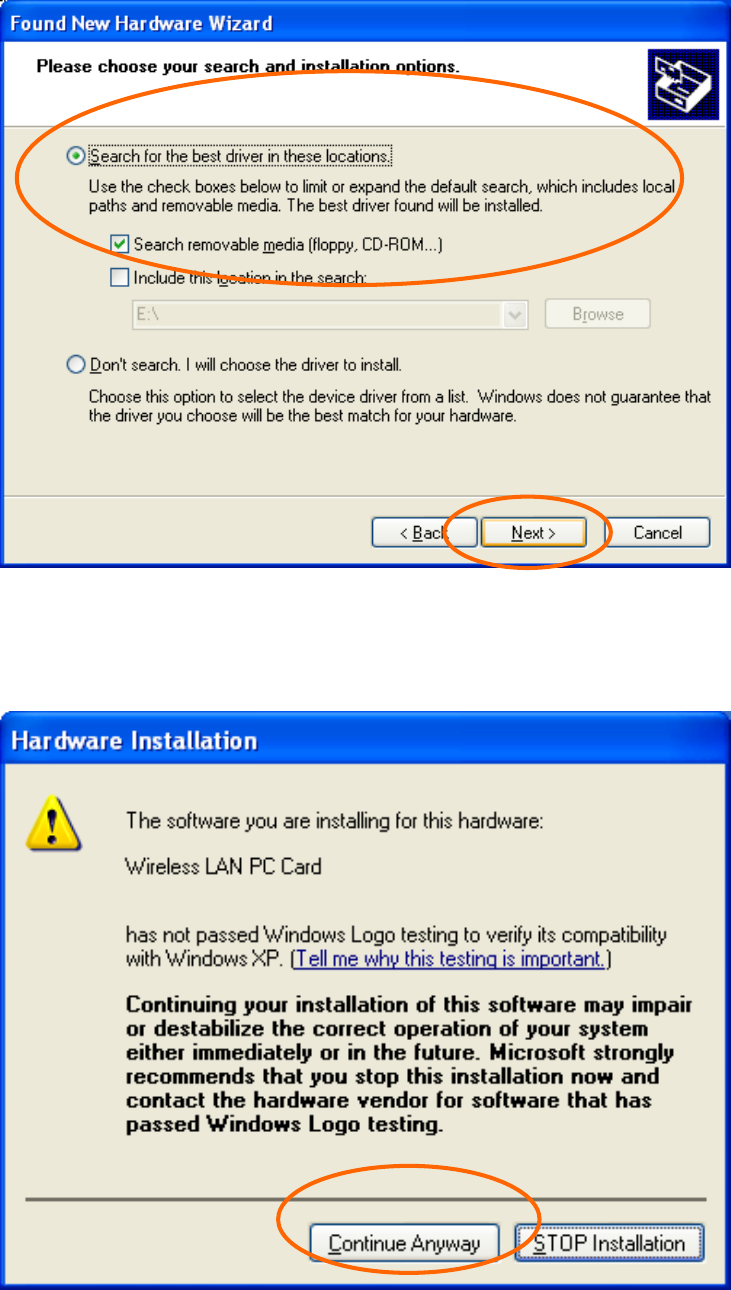
- 23 -
3. Click Continue Anyway to proceed.
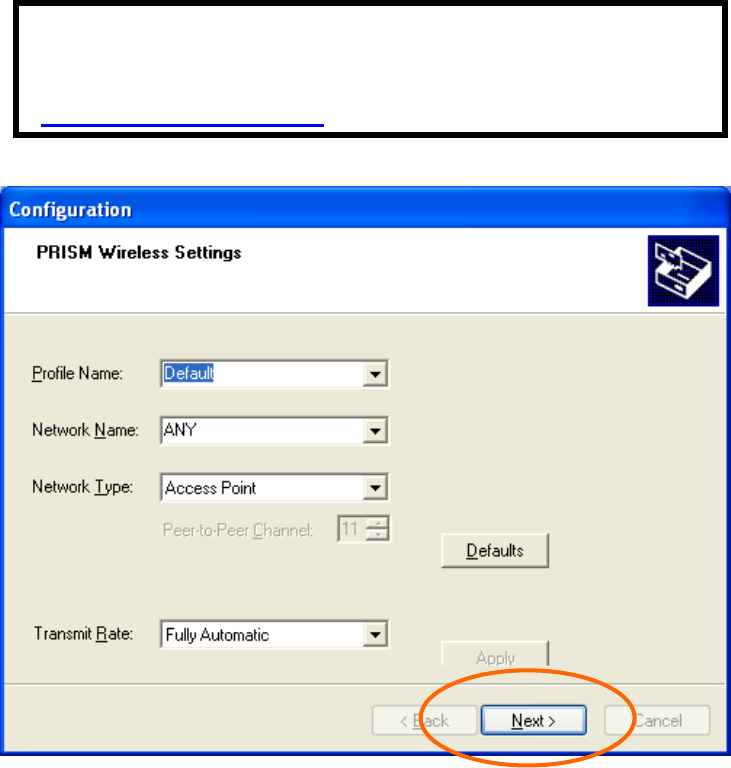
- 24 -
4. After windows XP copies the appropriate
driver to your system, the Configuration
window will appear and prompt you to
configure the Network PC Card’s driver
software, but the modification of default
settings may result in network errors. It is
recommended to remain the default settings.
Click Next to proceed.
Note: For the detailed ways to configure the
wireless PC Card, please refer to the
Configuration Utility section.
5. Click Finish. The software installation for
this network device is now completed.
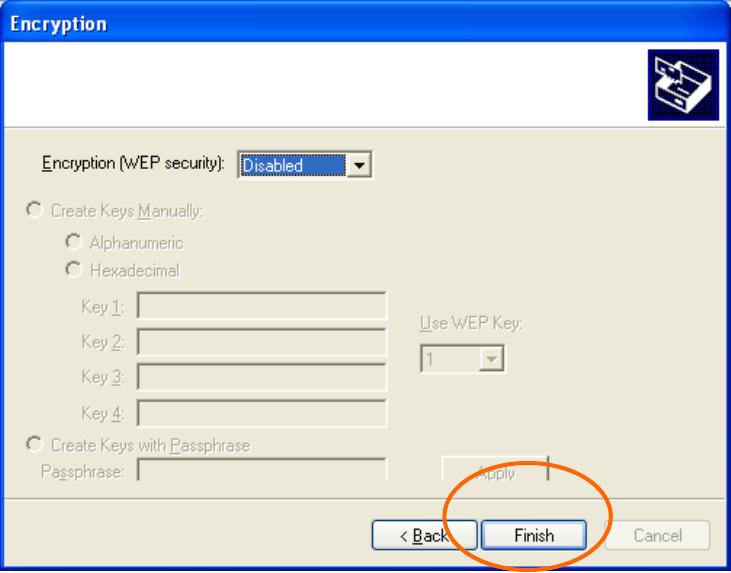
- 25 -
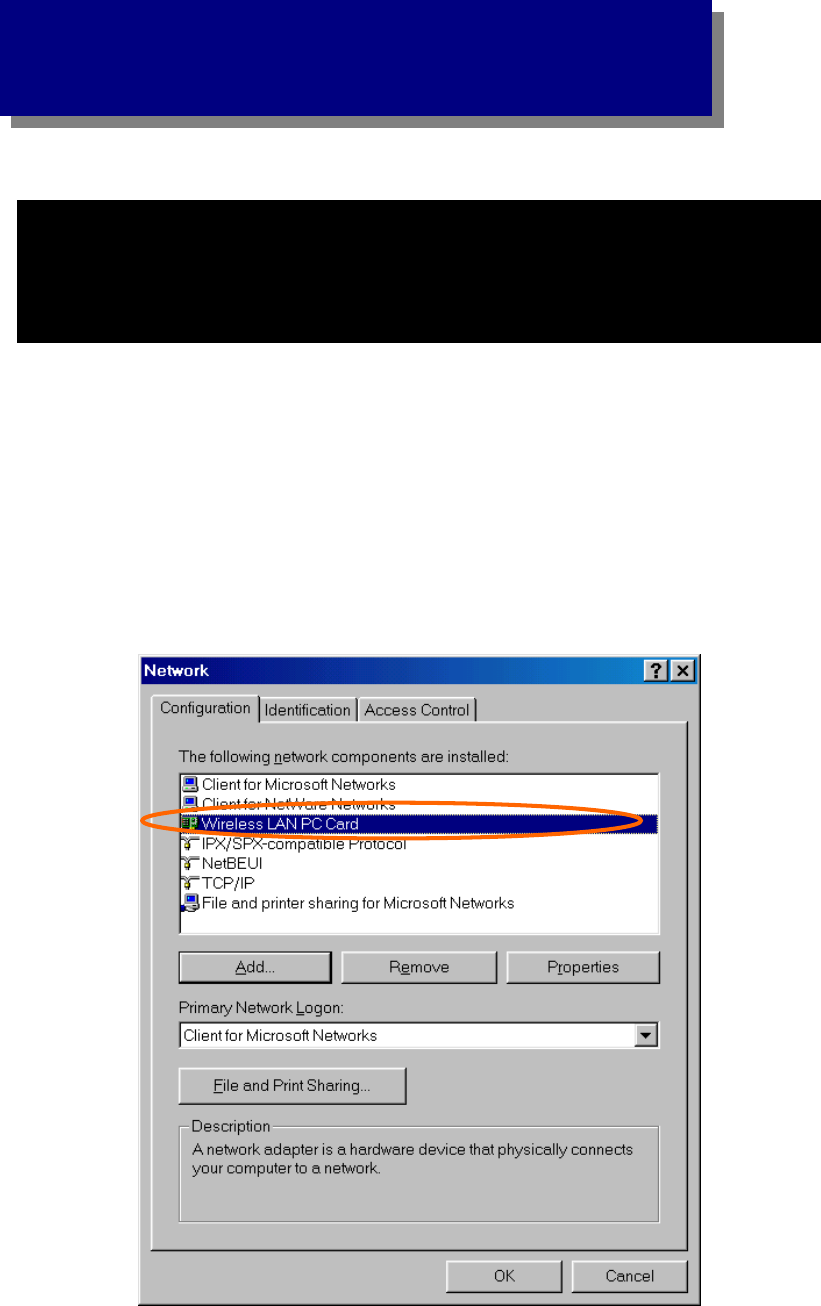
- 26 -
Network Connection
Configuring the Network Protocols for
Windows 95 (OSR2)/98/ME/2000
1. Once the driver has been installed, you must
make some changes to your network settings.
Click StartSettingsControl Panel
Network and make sure that you have all the
following components installed.
Wireless LAN PC Card
IPX/SPX-compatible Protocol
- 27 -
NetBEUI
TCP/IP
If any components are missing, click on the Add
button to add them in. All the protocols and
clients required and listed above are provided by
Microsoft. After clicking Add, highlight the
component you need, click Add, highlight
Microsoft, and then double click on the item you
want to add.
For making your computer visible on the network,
enable the File and Printer Sharing.
Click the Identification tab. Make up a name
that is unique from the other computers' names
on the network. Type the name of your
workgroup, which should be the same used by all
of the other PCs on the network.
Click the Access Control tab. Make sure that
“Shared-level access control” is selected. If
connecting to a Netware server, share level can
be set to “User-level access control.”
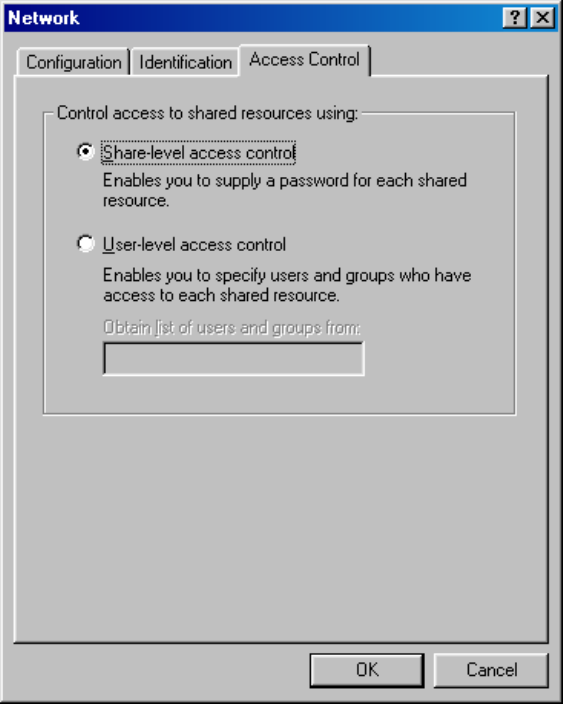
- 28 -
When finished, reboot your computer to activate
the new device.
Once the computer has restarted and Windows
has booted up, a Logon window will appear and
require you to enter a username and password.
Make up a username and password and click OK.
Do not click the Cancel button, or you won’t be
able to log onto the network.
Double-click the Network Neighbourhood icon
on the windows desktop, and you should see the
names of the other PCs on the network.
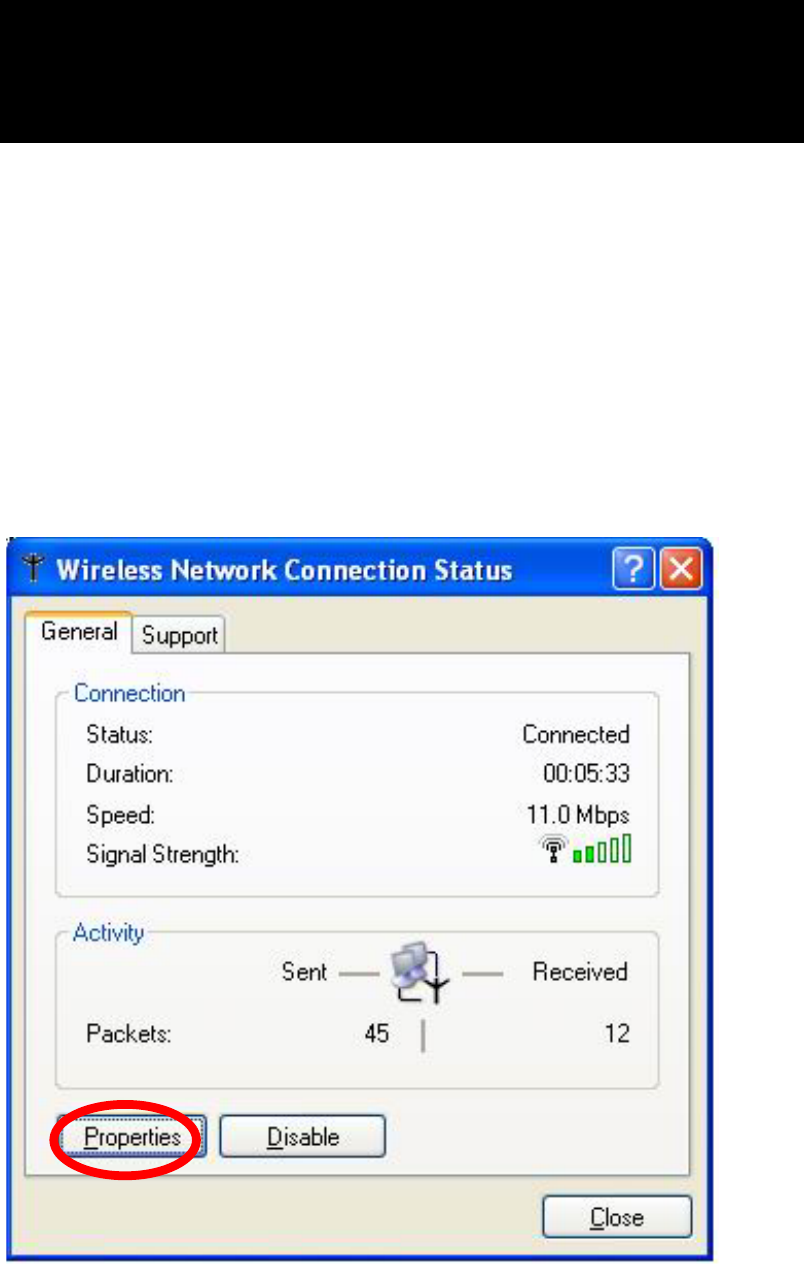
- 29 -
Configuring the Network Protocols for
Windows XP
Once the driver has been installed, you must
check if some necessary network components are
well setup in your computer. Click Settings
Control Panel Network Connections
Wireless Network Connection Enabled
Wireless LAN PC Card Properties.
Make sure that you have all the following
components installed.
Client for Microsoft Networks
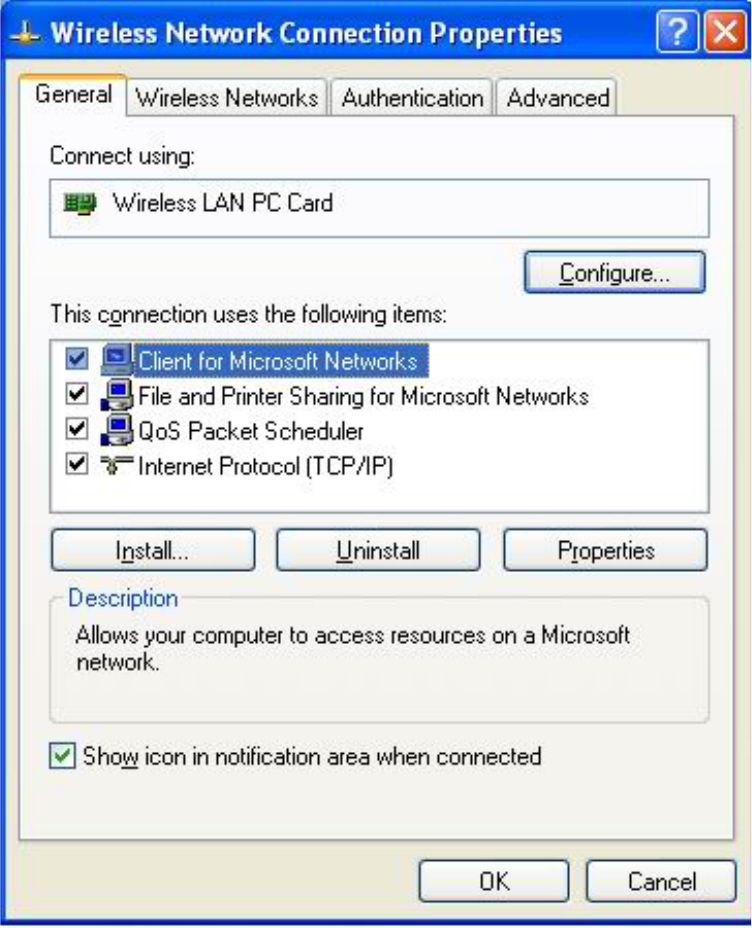
- 30 -
IPX/SPX-compatible Protocol
TCP/IP
If any components are missing, click on the
Install…button to select the clients/service/
protocols required. After selecting the
component you need, click Add…to add it in.
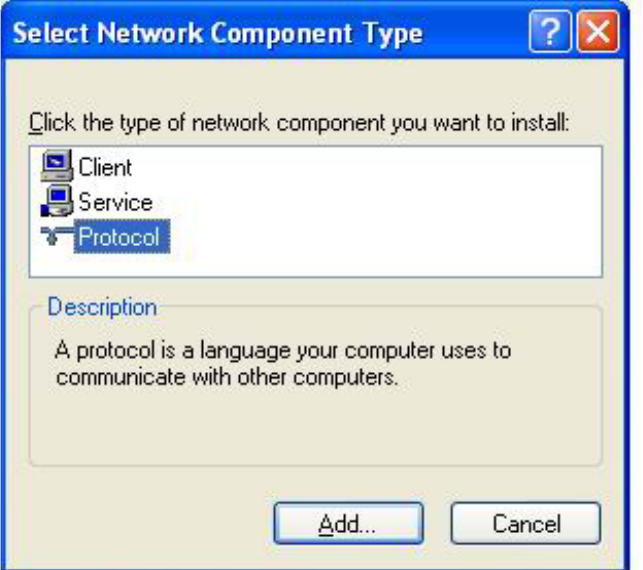
- 31 -
For making your computer visible on the network,
enable the File and Printer Sharing.
When finished, you must restart your computer to
complete installation.

- 32 -
Configuration Utility
After installing the Wireless PC Card’s driver
successfully, the Network Status icon will
appear in the taskbar.
Note: Except for the following configuration
utility, using Windows to configure the
wireless network settings in the Windows XP
is recommended. (Please skip to the
Configuration for Windows XP section)
Network Status Icon & Icon Menu
The Status Icon
Icon Link Status
Green indicates a strong link.
Yellow indicates a weak link.
Red indicates no or a very poor link.
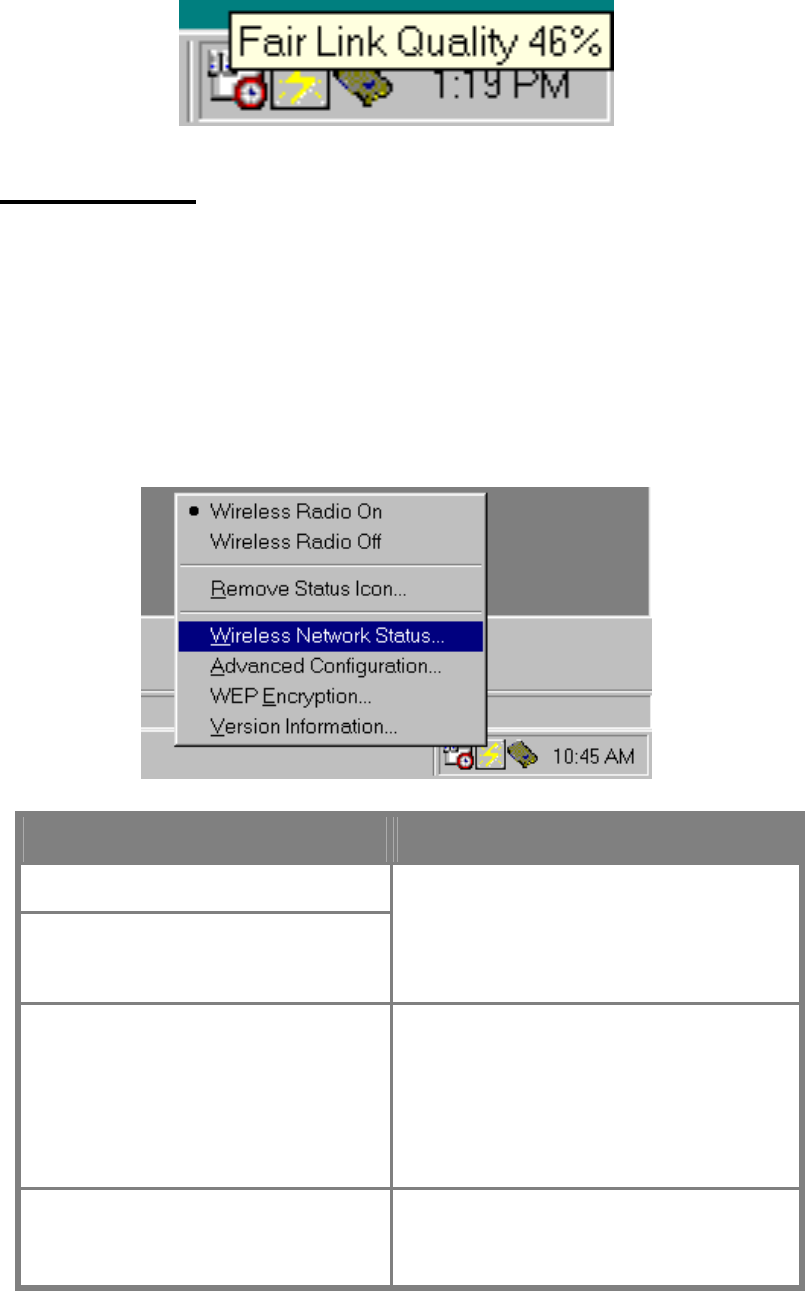
- 33 -
To view the exact link quality of the wireless PC
Card, move the cursor over the status icon, as
shown below.
Icon Menu
After clicking on the icon, the icon menu as
displayed below will prompt you to configure the
wireless PC Card.
Items Description
Wireless Radio On
Wireless Radio Off
These two items allows
you to enable or disable
the wireless radio.
Remove Status
Icon…
Removes the icon from
the taskbar. Each time
you power on your PC,
the icon will reappear.
Wireless Network
Status
Clicking these items will
launch the Wireless
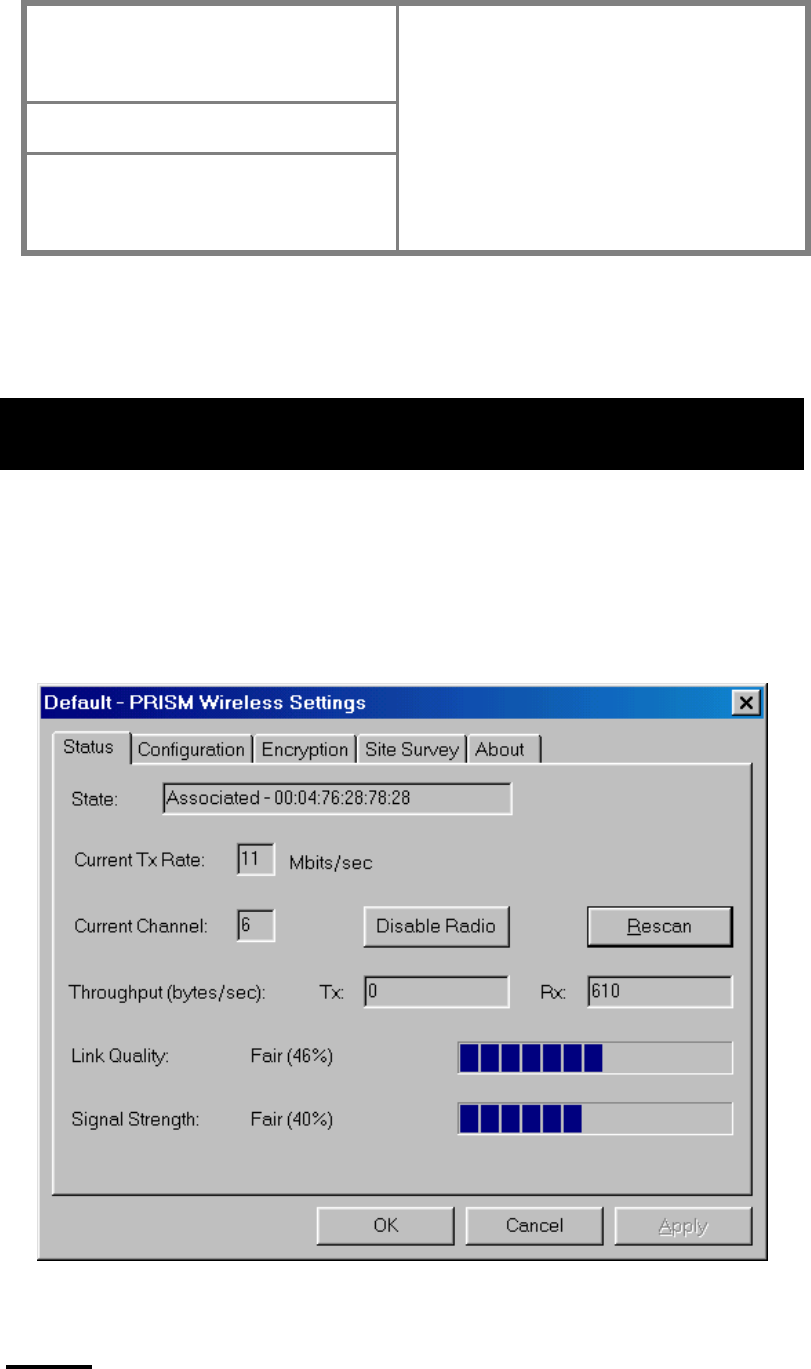
- 34 -
Advanced
Configuration…
WEP Encryption…
Version
Information…
Settings window, as
described below.
Status
The Status tab provides you the status of the
wireless PC Card.
State
Displays the connection state of the wireless PC
Card with the wireless network.

- 35 -
Current Tx Rate
Displays the current transfer rate.
Current Channel
Displays the channel that is currently used by the
wireless PC Card.
Disable Radio
Disables the wireless radio. The wireless PC
Card will disconnect with the wireless network.
Rescan
Forces the radio to rescan all available channels.
While the link quality is poor, clicking on the
button to search for a better connection.
Throughput
Displays the transferring (Tx) and receiving (Rx)
data rate in bytes per second.
Link Quality and Signal Strength
Displays the quality and strength of the
connection between the wireless PC Card and the
Access Point it connects.
Configuration
The Configuration tab allows to set parameters
for the wireless PC card.
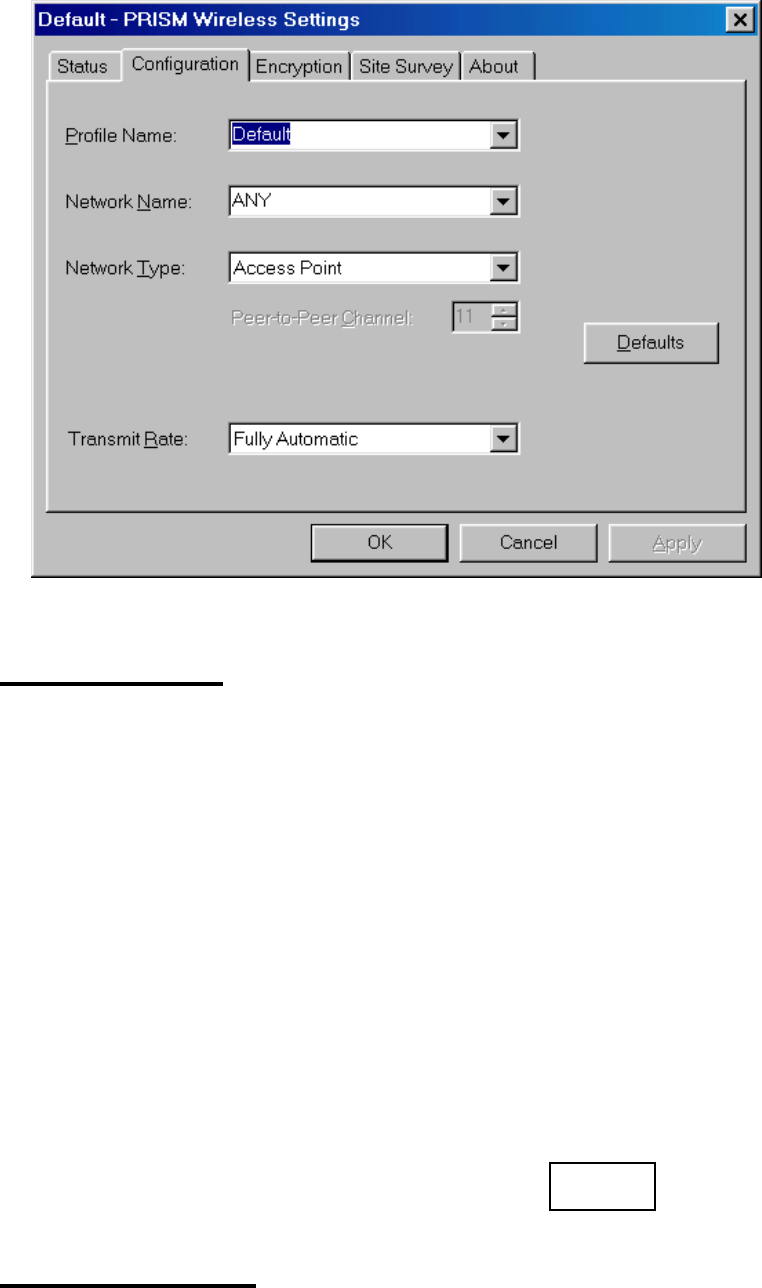
- 36 -
Profile Name
Saves values for all previous setting parameters.
The default values contain the parameters
configured at installation.
Once the demands for switching between
different networking environments are required,
you can also set the additional profiles to
eliminate the configuration time. To save the
current parameters, highlight the Profile field,
type a new name, and click on the Apply button.
Network Name (SSID)
A specific name shared among connected
wireless PC Card, Access Points and other
wireless stations on the wireless network. The

- 37 -
name must be identical for all devices and points
attempting to connect to the same network. The
default name is ANY. To change the Network
Name, simply enter a new name in the field and
click on the Apply button.
Network Type
The Network Type setting determines the
arrangement of your wireless network. The
supported modes displayed are Access Point and
Peer-to-Peer.
Access Point – The default settings. This
mode lets you connect the wireless LAN to
a wired and existed network via an Access
Point.
Peer-to-Peer – The mode is used for
sharing information between wireless PC
Cards without Access Points.
Note: For the detailed illustration about
Access Point and Peer-to-Peer modes,
please refer to the Wireless Network
Options section.
Transmit Rate
The default setting is Fully Automatic. There
are other options, 5.5Mb, 11Mb, Auto 1Mb or

- 38 -
2Mb. For best performance, it is recommended
to remain the Fully Automatic setting.
Peer-to-Peer Channel
To communicate with other wireless PC Card,
you must specify the same channel. Click the
up and down arrow at the right of the
Peer-to-Peer Channel to set the desired channel.
The field is grayed out in Access Point mode.
Defaults
Clicks the button to restore to the default settings.
Encryption
WEP (Wired Equivalent Privacy) encryption can
be used to ensure the security of your wireless
network. The window allows you to set to 64bit
or 128bit Encryption (WEP) by using either
Passphrase or Manual Entry methods.
Note: To allow Decryption and communication,
all wireless devices must share the identical
encryption key on the same network.
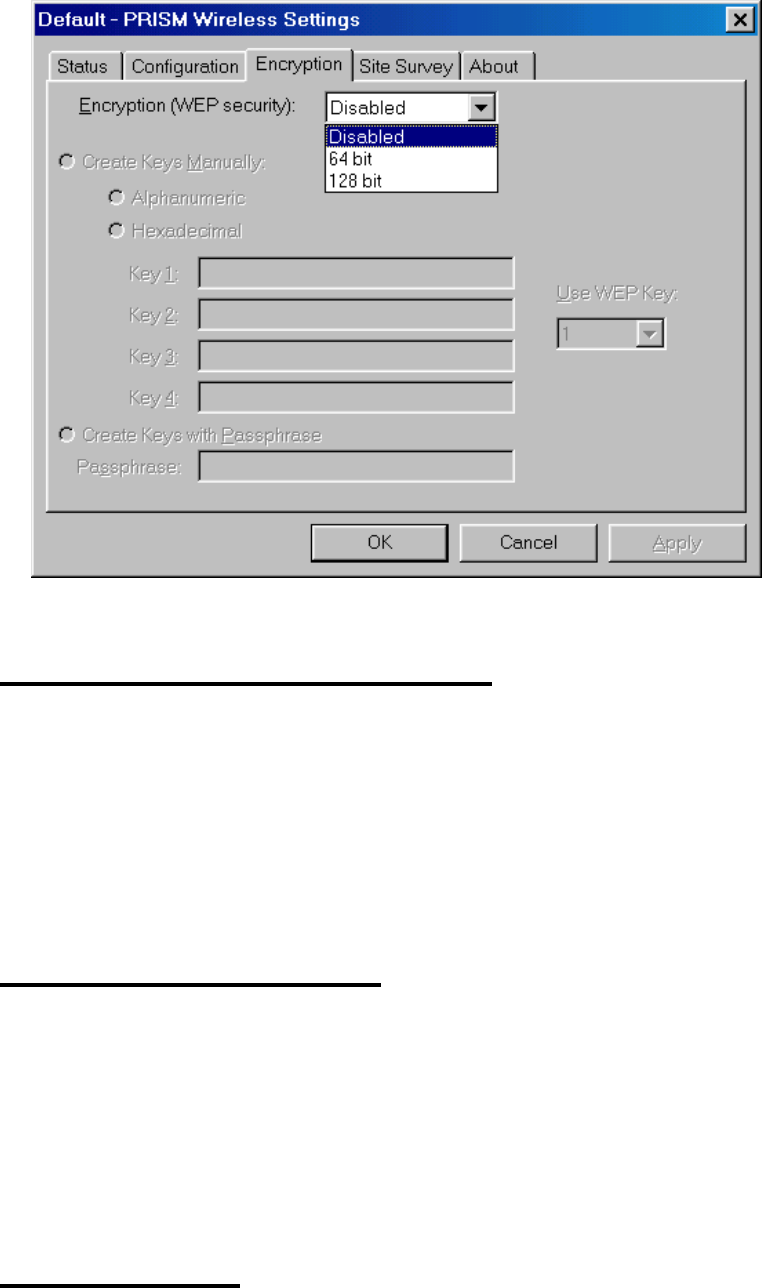
- 39 -
Create Keys with Passphrase
A Passphrase can be entered to generate four
keys used for WEP. For the easiest
configuration, the Passphrase method is
recommended.
Create Keys Manually
These four fields can be used to enter WEP keys
manually. The method is required to match the
keys of other wireless devices on the existing
network.
Use WEP Key
The default key field can be used for specifying
which of the four encryption keys to transmit data
on the wireless network.
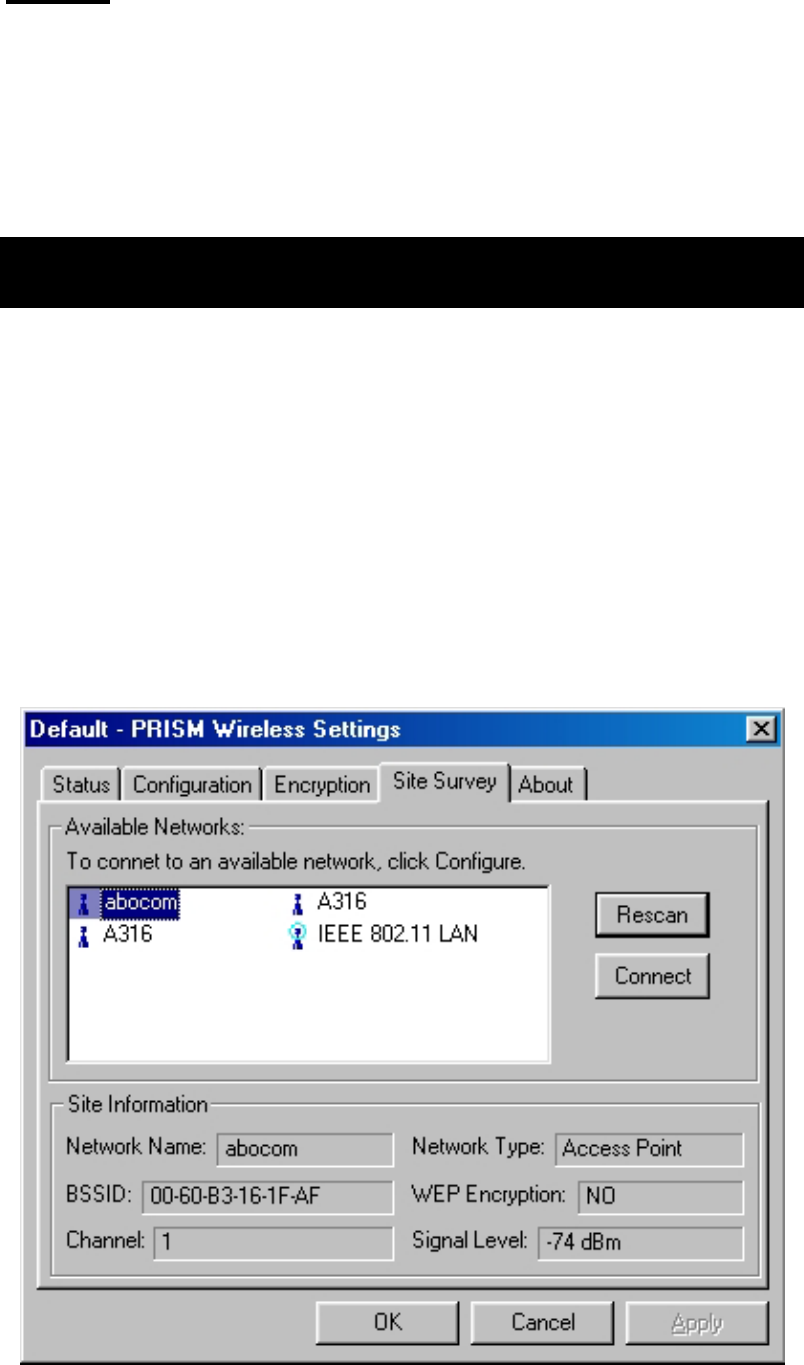
- 40 -
Apply
Once you set up the encryption (WEP), click on
the Apply button to activate the settings.
Site Survey
The Site Survey tab shows all the available
Access Points and their information.
Highlight the access point displayed in the left
list box, and you can see its features illustrated in
the following fields.
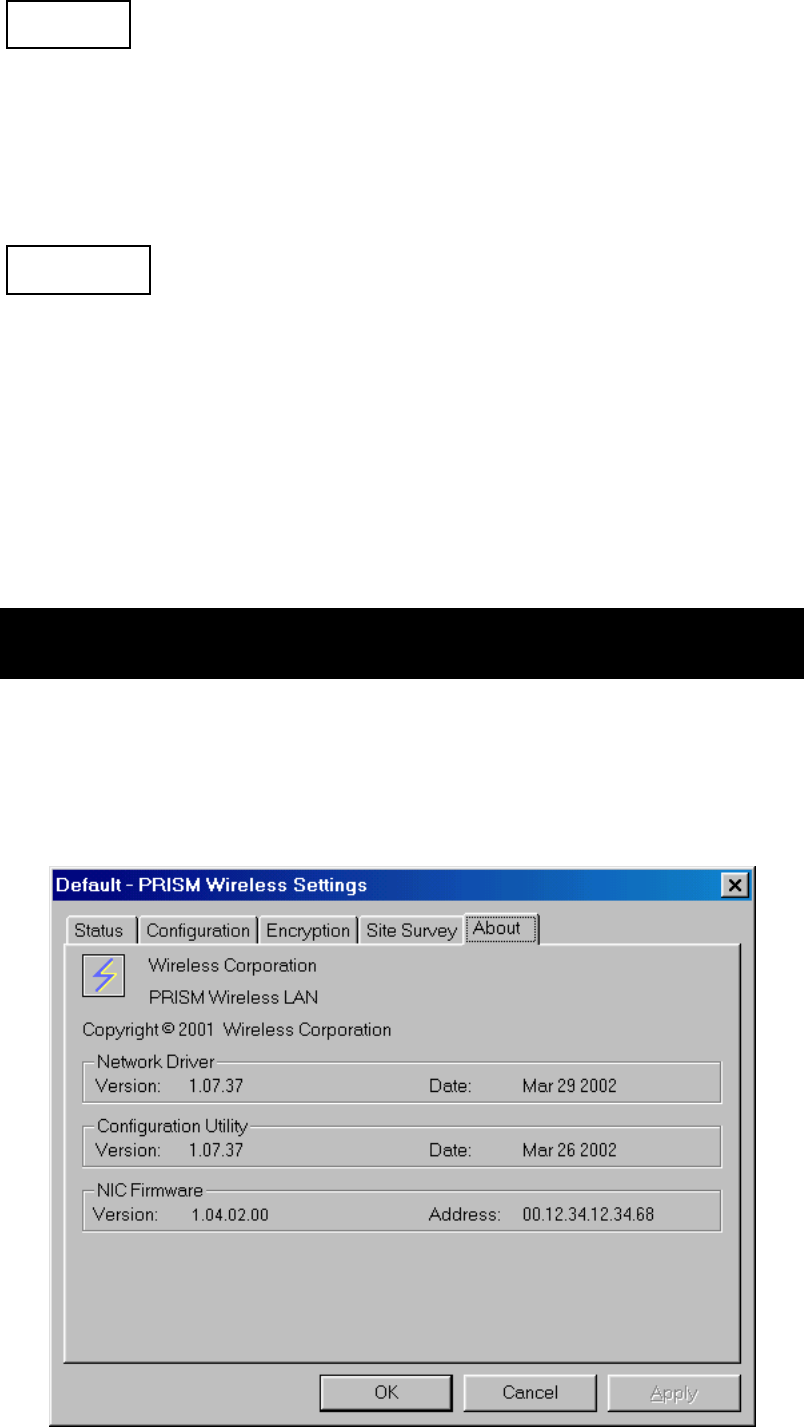
- 41 -
Rescan
Searches for all available networks. Clicking on
the button, the PC Card will start to rescan and
list all available sites in the left box.
Connect
To connect with a new access point, highlights
the desired one in the left list box and clicks on
the Connect button. Wait a while and the
selected one will be marked as a current used
access point.
About
The About tab shows the information and
version of the Configuration Utility.
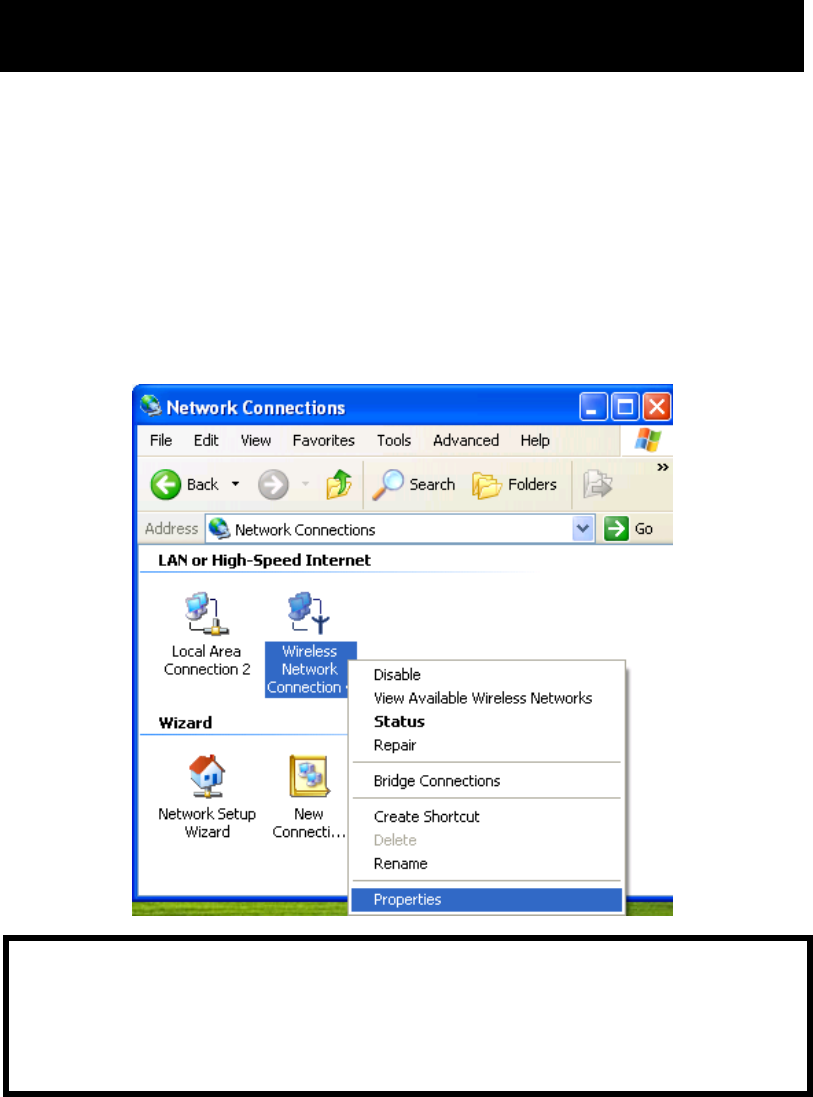
- 42 -
Configuration for Windows XP
1. Go to Start Control Panel Network
Connections.
2. In Network Connections window,
right-click the Wireless Network
Connections icon, and select Properties.
Note: Double-click the Wireless Network
Connection icon and you can see the status of
the wireless PC Card as described below.
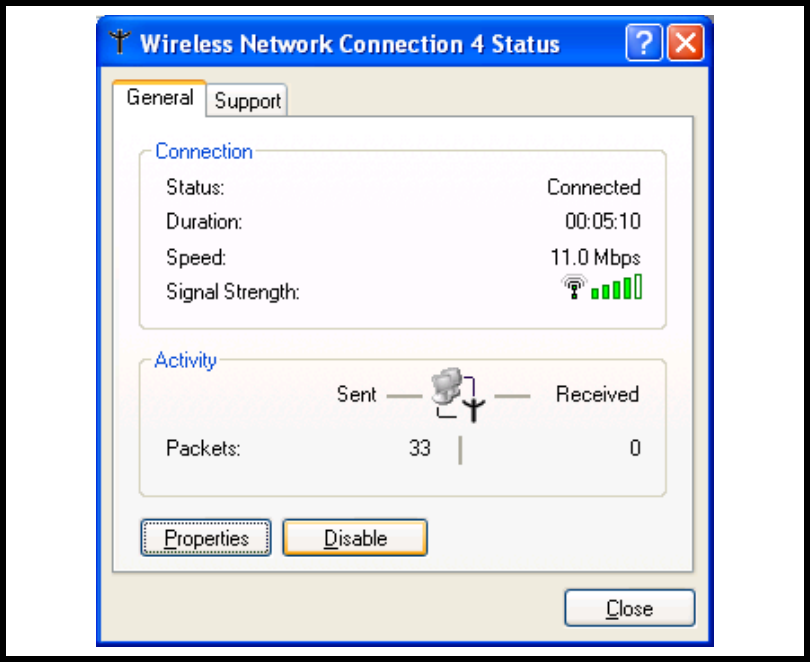
- 43 -
3. In Wireless Network Connection
Properties window, select the Wireless
Networks tab.
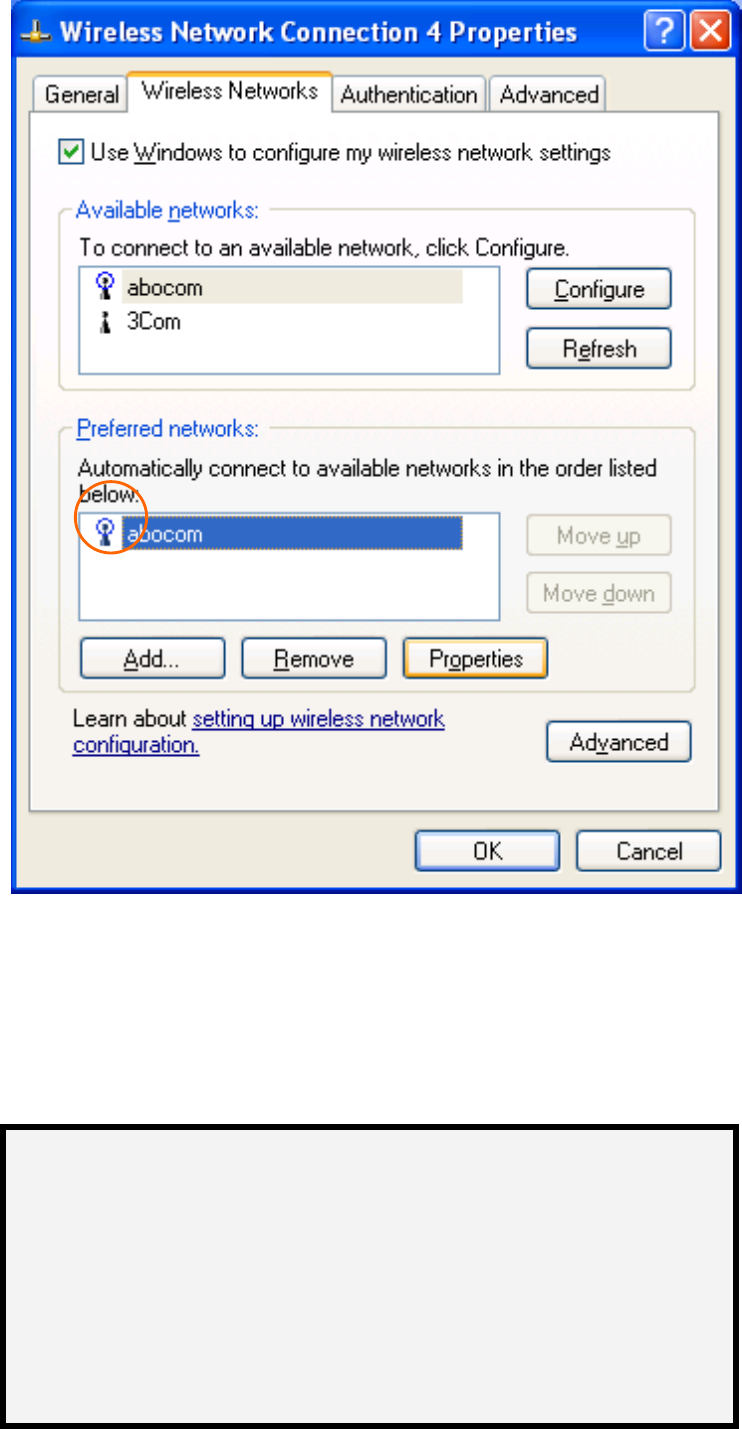
- 44 -
Use Windows to configure…
Check the box to enable windows configuration.
Note: Once you enable windows
configuration, there will be only two tabs,
Status and About, left in the
Configuration Utility. You cannot use
this utility to configure the wireless
settings.
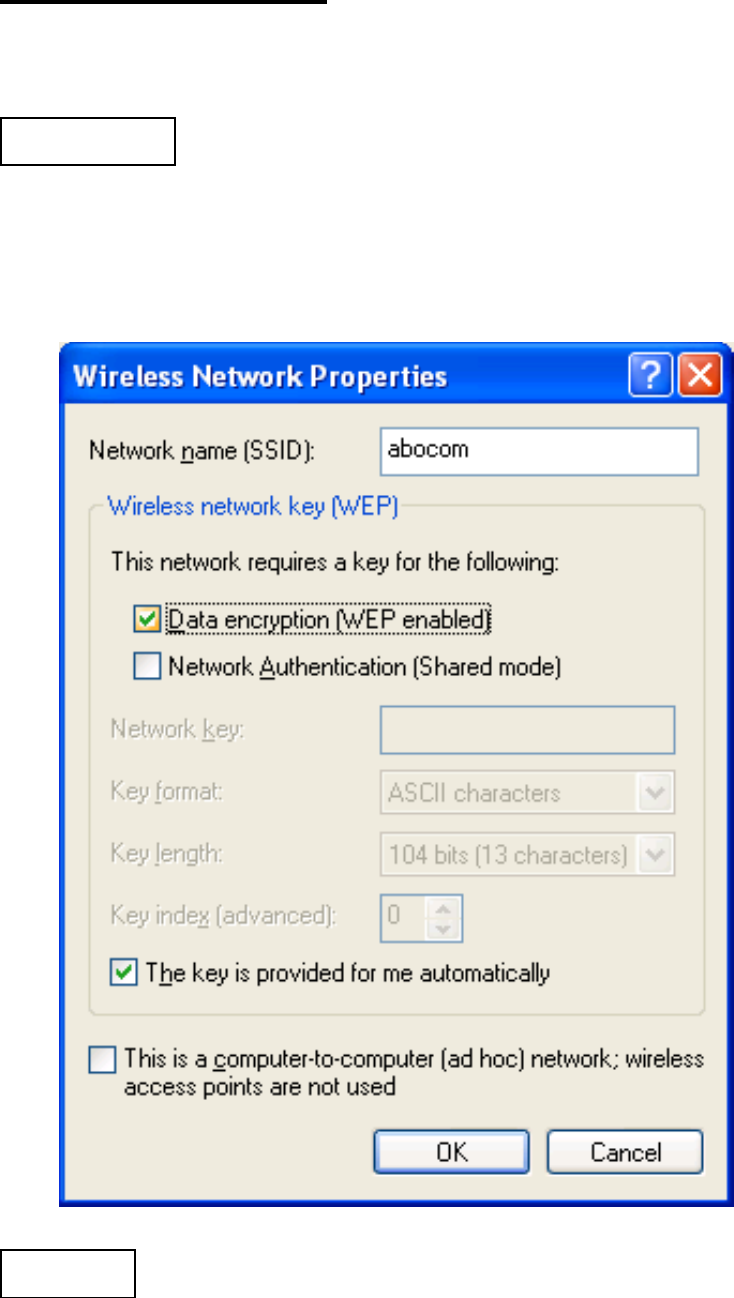
- 45 -
Available networks
Displays all available networks.
Configure
Click the button to set up a new network or WEP
configuration as illustrated as below.
Refresh
Click the button to refresh and search for all
available networks.

- 46 -
Preferred networks
From available network(s) listed above, you can
select preferred one(s) in an order that you can
arrange.
The marked one is the currently used network.
Move up
Move the selected network forward one position.
Move down
Move the selected network back one position
Add…
Click the button and the Wireless Network
Properties window will appear. In the
Network name field, enter your desired network
name listed in the above Available networks box,
and click OK.
Note: The new settings will be active only
after you click on OK in the Wireless
Network Connection Properties window.

- 47 -
Remove
Highlight the unwanted network listed in the
Preferred networks box, and click the button to
remove it.
Properties
Highlight the network listed in the above
Preferred networks box, and click the button to
display its properties.
Once network configuration is done, make sure to
click OK. The new parameters will be saved
and active only after doing so.

- 48 -
Specifications
Standards IEEE 802.11b, Wi-Fi compliant
Host Interface PC Card Type II slot
Physical Weight: 40 g
Dimension: 119(L) x 53.94 (W) x
6.88(H) mm
Antenna Built in the card
LED Indicators Link: Orange
Act: Green
Power
Requirement
Operating Voltage: 5V
TX consumption: 300mA (Max)
RX consumption: 200mA (Max)
Sleep Mode: 17 mA
Frequency
Range
2.412GHz-2.4835GHz
Number of
Selectable
Channels
USA, Canada: 11 channels
Japan: 14 channels
Europe: 13 channels
Modulation
Technique
Direct Sequence Spread Spectrum
(CCK, DQPSK, DBPSK)
Security 0/64/128 bit WEP
Spreading 11 chip Barker sequence
Bit Error rate Better than 10-5
Media Access
Protocol
CSMA/CA (Collision Avoidance) with
ACK

- 49 -
Protocol ACK
Range (meter) Standard Speed
(2 Mbit/s)
High Speed
(11 Mbit/s)
Open
Environment 320m 220m
Supported OS Windows 95(OSR2)/98/ ME/ 2000/XP
EMC
Certification
- FCC Part 15, Class B in US
- EN300328/826 (301489-17) in Europe
- JATE-Telec in Japan